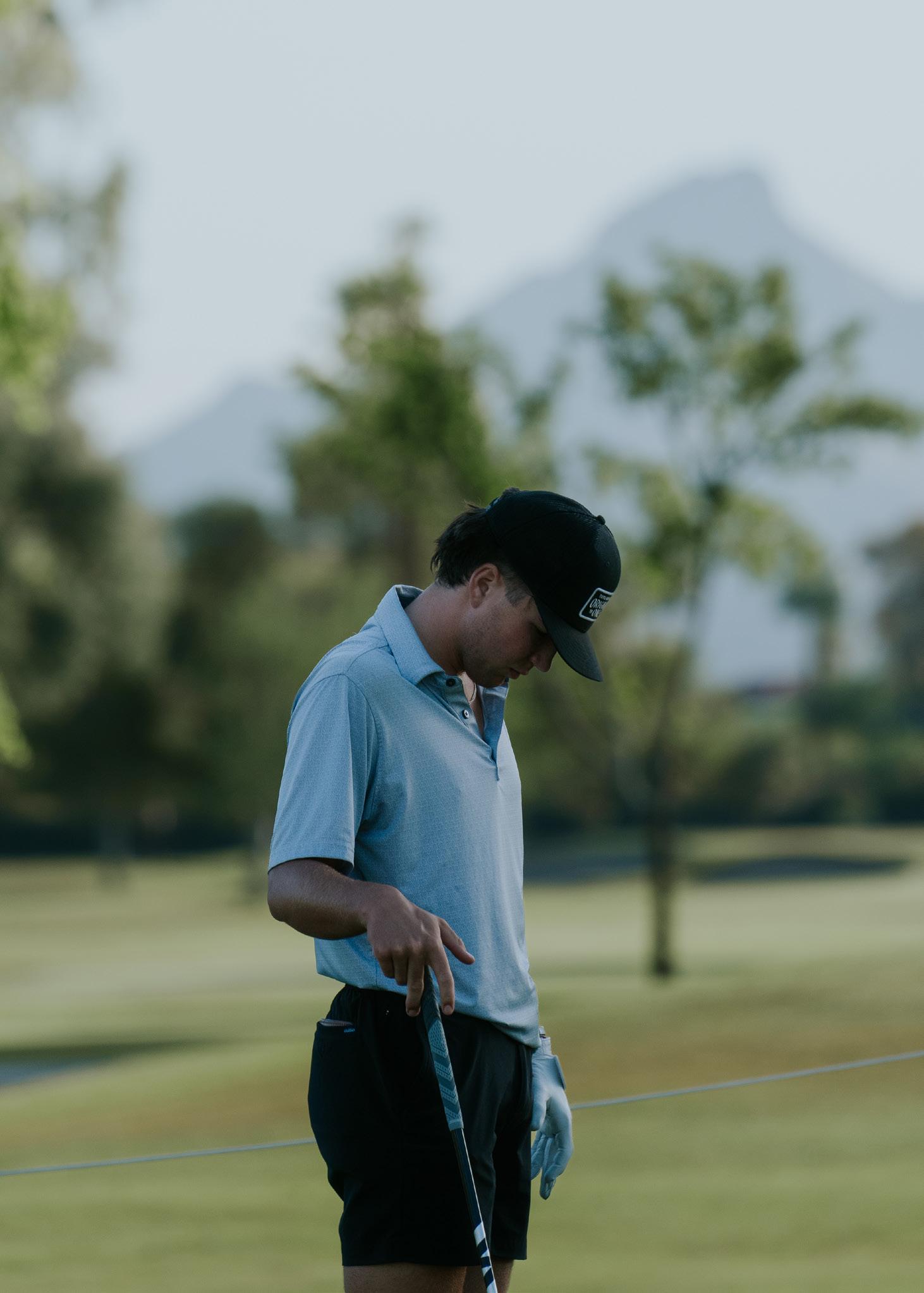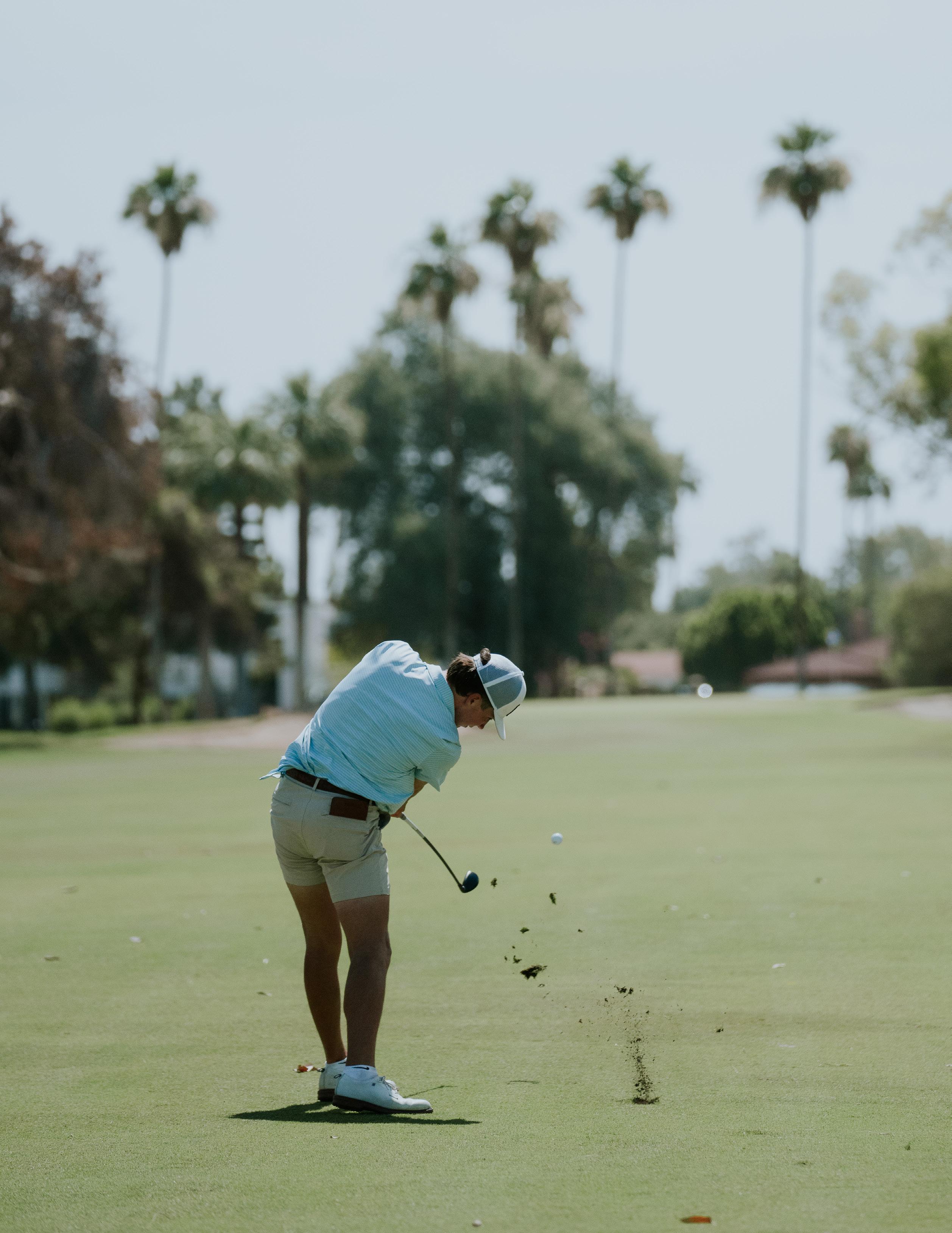










Editor In Chief

Preston McFarland
Creative Director & Editor Alex Johnson
Art Director & Designer Tyler Flanagan
Writers PJ Baron
Jordy Barrett
Michael Croley
Brandon Genson
Michael LoRé
Georgann Yara
Photographers
Other Contributors
Jordy Barrett
Brandon Genson
Alex Johnson
Preston McFarland
Michael Williams
Michelle Glicksman
Eric Hickenlooper
Everett Priddy
Daniel Shoup
Kylie Shoemake
Peg Tanner



This three-row SUV has it all. Available powerreclining second-row captain’s chairs, dual wireless phone charger and front-and-backopening center console that everyone can access are more than part of our redesigned SANTA FE. They’re changes that luxuriously accommodate the way you navigate life.
All this plus the Earnhardt No Bull Way of doing business that’s made us a trusted name in the Valley since 1951. Still offering world class service and our famous low prices. The way Tex did it and that’s a family tradition that’s never going to change.





As asphalt-melting temperatures scorch Arizona, indoor golf simulators provide an alternative routing for those both new to the game or looking to improve.
Words by Michael LoRé






Cheri Groves was your stereotypical golf spouse. She’d ride along in the cart a few times a year with her husband, although she generally preferred the spa, pool, or beach while Casey golfed. Groves was interested in the game, but a back injury in 2004 limited what she could physically do. Or so she thought.
The couple, along with some friends, were bitten by the golf bug after attending the 2024 WM Phoenix Open and so headed to TeeBox Indoor Golf Club, an indoor golf facility in Cave Creek. Cheri and Casey had first visited when it initially opened.
Enjoying a cold brew martini like she did during her inaugural visit, an employee asked Groves why she wasn’t playing golf. After explaining her prior back problems, he suggested she take a few swings while he offered some pointers.
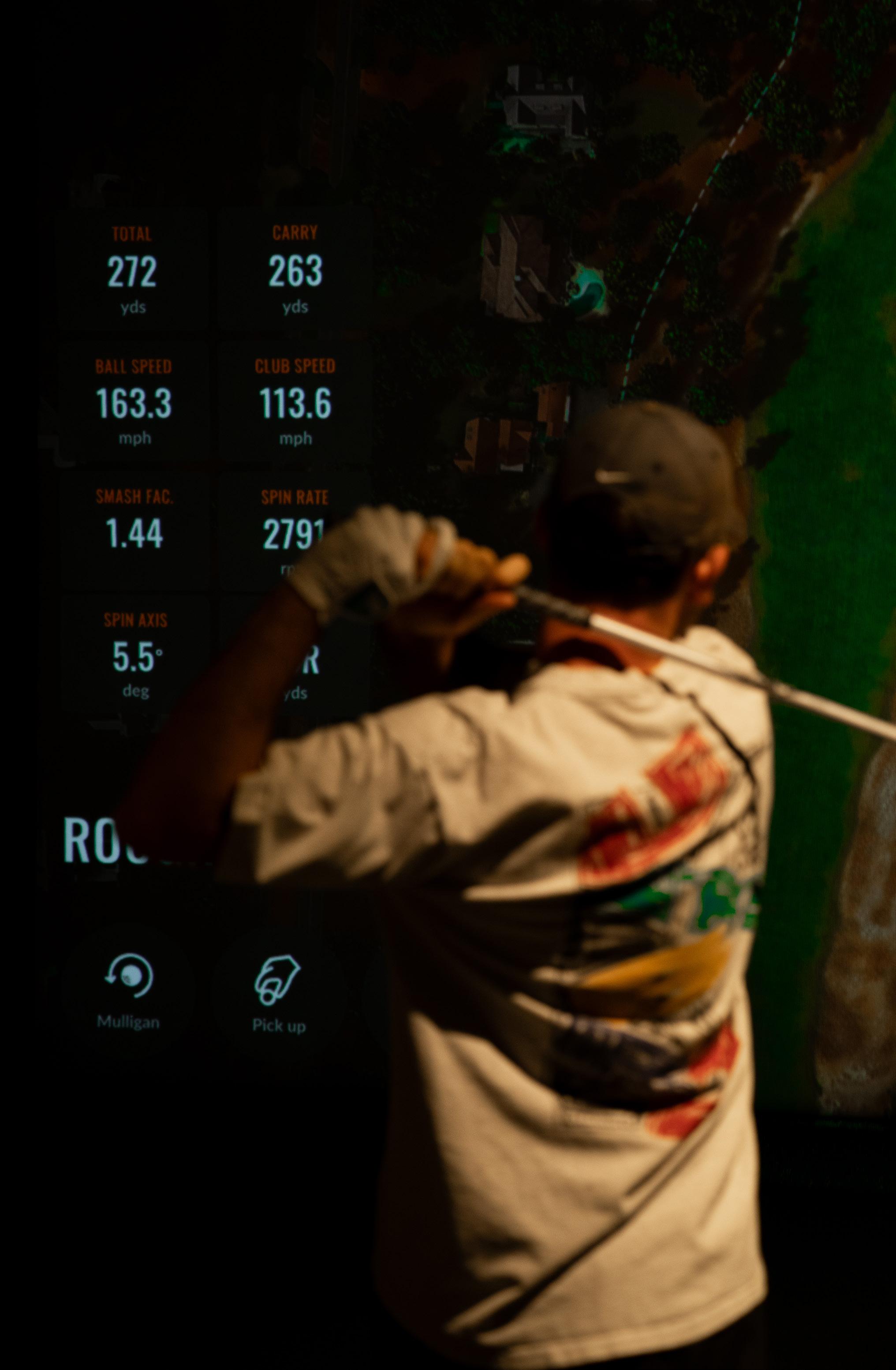
Groves hasn’t put down a club since.
“I wouldn’t be playing golf today had I not visited TeeBox,” she says. “I encourage every woman or man that is not sure if they want to play to please go visit them. I have two friends who have converted to golf recently just from my progress. If I can do it, anyone can do it.”
Groves’s story is not unique—it’s another example of how indoor simulator golf has grown to complement traditional green-grass golf as the game has become more popular than ever before. With countless barriers to entry ranging from extensive costs (greens fees, equipment, apparel) to the time commitment and even intimidation factor weighing heavily on novice golfers, indoor simulators offer a safe haven in which to hone their game and build confidence.
TeeBox Indoor Golf Club Cave Creek
Fairway Dreams Indoor Golf
Tee Timez
The Back Nine
Trevor’s Liquor
Zion Golf Club
Bushwood Sims @ W Scottsdale
Ryder NDoor Golf

Gilbert
Chandler
Scottsdale
Scottsdale
Scottsdale
Scottsdale
Scottsdale
Stinger’s Golf Club Chandler
Agave Golf Club
Loft Golf Studios
Par Lab Tempe
Club Twirl Golf Lounge
iSwing Indoor Golf Anthem
Arizona Golf Exchange Tucson
A record-setting 45 million Americans ages 6-plus played both on- and off-course golf in 2023, according to the National Golf Foundation. Within that total, 26.6 million played on a course, while another 18.4 million participated exclusively in off-course golf activities at places like driving ranges, indoor golf simulators, or golfentertainment venues like Topgolf and PopStroke.
While Arizona boasts almost as many sunny days a year (300) as it does golf courses (373), getting a tee time can be difficult depending on the season. During peak winter months, courses are teeming with locals and tourists taking advantage of idyllic conditions, while hot summer months limit tee times to dawn and dusk for many. Droughts and water shortages also make it difficult to maintain and manage golf courses in the desert.

“You have this increasing golf demand and a decreasing supply, so the solution is offcourse,” TeeBox owner Jim Bucklin says. “It has to be.”
A lifelong golfer, Bucklin became obsessed with simulator golf when he was first introduced to Trackman in late 2019. After 10 minutes of hitting balls while getting tons of immediate data and feedback, as well as learning that he could also play virtual courses without having to travel, Bucklin bought one.
“Within a month I was so excited about it, I spent $55,000 to put a simulator in my house,” he says. “I sold a Porsche, moved my club car from one garage to another, and got rid of my woodshop to be able to put a sim in. It was that fun. I played it all the time. I just loved it.
“After about a week or so of having it set up, I thought, ‘This was an extraordinary amount of money and effort to get this done, how come there isn’t somewhere to go and do this and pay by the hour?’”
Realizing many indoor golf simulators were traditionally in markets with limited golf seasons due to inclement weather or limited locally to golf shops like GOLFTEC,
Golf Galaxy, and DICK’S Sporting Goods for club fitting purposes, Bucklin had his “aha moment” and TeeBox was born.
Opened in December 2023, TeeBox is an 11,100-squarefoot facility featuring 11 19-foot simulator bays each boasting Trackman technology. The facility also offers instruction, club fittings, food and beverages, as well as live music on a 4,400-square-foot outdoor patio.
Offering a place to grind and fine-tune for diehard golfers, as well as a less intimidating atmosphere for youth and amateurs, indoor simulators are popping up across the Grand Canyon State — especially in the Valley — with Fairway Dreams Indoor Golf (Avondale), Tee Timez (Mesa), The Back Nine (Gilbert, Chandler, Scottsdale), Trevor’s Liquor (Scottsdale), and Zion Golf Club (Scottsdale).
Equipped with launch monitor and data-collecting technology from brands like Trackman, Foresight Sports, and Rapsodo, indoor golf simulators give novice and experienced golfers opportunities to collect, analyze, and improve the game’s minutiae.
While the amount of data can certainly be overwhelming, especially to those new to the game, Trackman recommends six numbers every amateur golfer should know: face angle, club path, impact location, attack angle, low point, and carry.
Offering opportunities to trial, tweak, and improve, golfers can then take their learnings from the indoor simulator onto green-grass courses where, hopefully, their improvements will pay major dividends.
“The more simulators there are, to me, the more golf rounds that are likely because you’re exposing more people to the game,” says Five Iron Golf cofounder and Chief Golf Officer Mike Doyle. “Once you get a feel for it, you want to take what you’re working on at the simulator onto the course. It’s not either indoor golf or going out to play. It complements it in many ways more than it replaces it.”

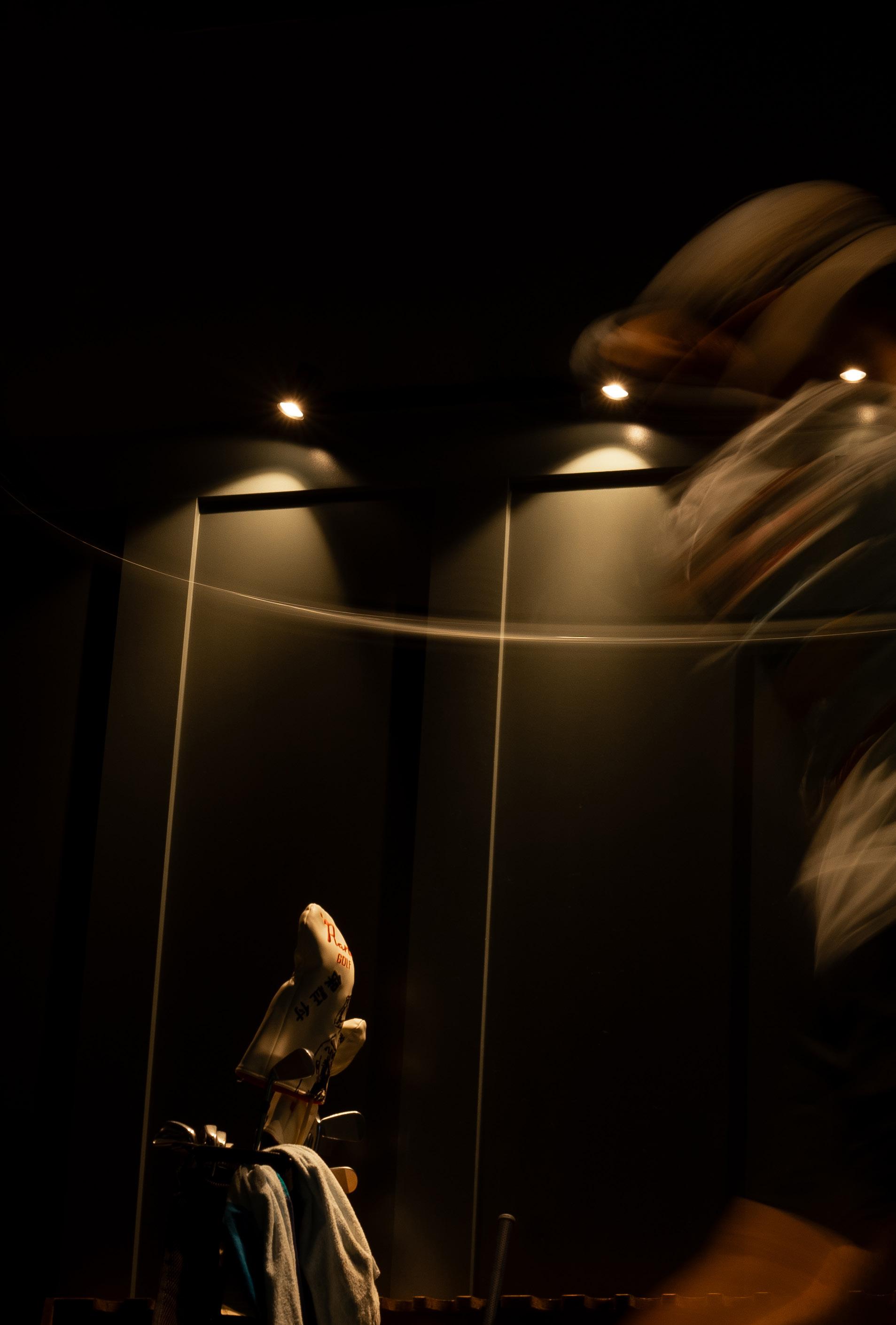
It complements it in many ways more than it replaces it.”
Founded in 2017 in New York City, Five Iron Golf boasts 30 locations domestically and internationally in cities including New York City, Chicago, Atlanta, and Seattle. Backed by Topgolf Callaway Brands, which announced a $30 million investment in 2021, Doyle said he’s bullish on expanding the brand into warm-weather locales like Scottsdale and Miami as a way to complement the growing golf obsession, while offering more yearround playing, technologybacked data, and instruction options.
“Warm weather doesn’t scare us like it once did, and it’s certainly something we’re broadly exploring,” he says. “We want to make it easier, not harder, to play golf everywhere, not just at Five Iron.”
With golf more popular than ever and land and resources at a premium to build new courses, especially in Arizona, indoor golf simulators offer data- and tech-driven experiences that not only support greengrass golf for experienced players, but also offer an easier entry point for those getting into the game.
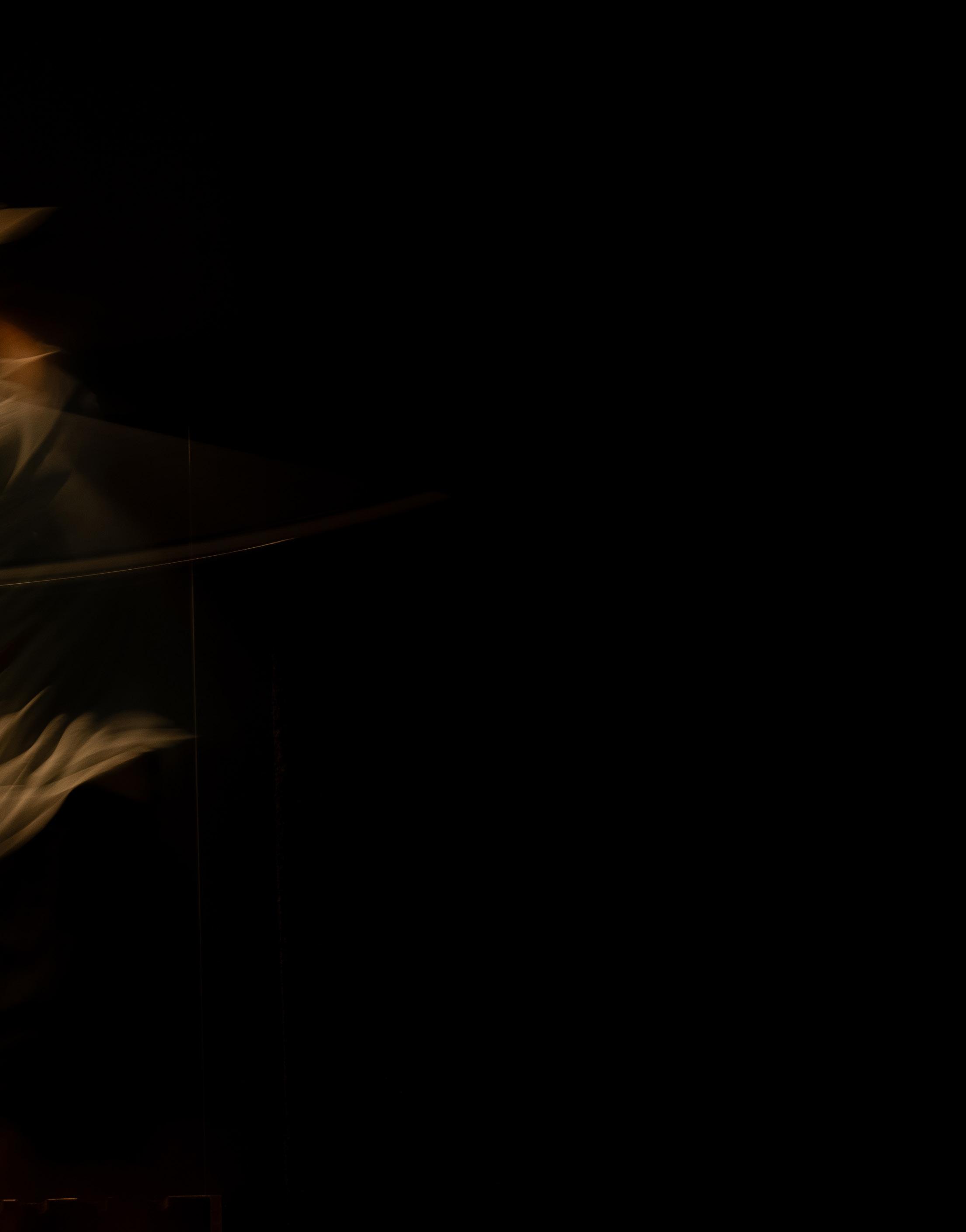


Technological advancements have evolved simulator golf from kitschy, video gamelike gameplay into authentic golf experiences, while reducing the barrier of entry as golf and entertainment continue to collide in the game’s new era.
“When you’re playing a virtual course,” Bucklin says, “it’s not like golf, it is golf.”


drop a quarter. drop a putt.




Words by Michael Croley
Golfers and smokers make for strange bedfellows but who else is willing to suffer for their vice like this odd couple? Who among us has not seen the smoker stoke that cherry in the freezing cold or blistering sun? Golf, a game founded on the coast of Scotland where rain jabs at 45-degree angles and the wind kicks as hard as a mule, feels less like a sport and more like a sacrament in such conditions.
Golf probably should have never found its way to the desert, but that ship set sail with irrigation and population booms, and now desert golf and saguaros are as much a part of the golf landscape as the sea and gorse. Each winter the state is flooded with snowbirds in search of warmer climes, sometimes extending their stays into May when spring is fleeting and summer begins to infiltrate. By June they’ve all left, and with their absence comes wide-open tee sheets and convection oven temperatures. But because of the former, Arizona golf eschews the comfort of air-conditioning.
From the outside looking in, Arizona golfers might as well be crazy. But while the rest of the country is enjoying prime golf season, desert golfers don’t beat the heat — they embrace it.
They make friends with it, hardening their bodies and their minds, preparing in the shoulder season. Don’t fight it but learn to live with it. And when all the snowbirds have returned home, the locals know that rising temperatures mean better rates and a leisurely pace of play.
Chris Ray of Gilbert says, “When the temperatures are that high, you can play a course that’s typically $280 for $40 bucks, and it’s just so wide and open. Nobody’s around you, which is just beautiful.”
A recent GolfNow search in June revealed only a handful of courses above $75, with most hovering around $35.
Ray travels all over the Valley for a deal, though he plays mostly out of Greenfield Lakes Golf Course in Gilbert, a breezy par-62. But it’s more than price driving Ray. It’s his passion for the game. He says no temperature is too high for him to stay away from the course, though he is committed to a regimen that makes the heat tolerable and safe. His mornings begin with Liquid IV or other hydration drinks. Cold towels, which many courses offer, are also important. And shade, the home appraiser says, “Shade is the best real estate in Arizona in the summer.”



Ray plays five days a week — and sometimes he’ll even play 36 on those days. On particularly hot days, he’ll come home, strip down to his shorts, and just fall in his pool. And while he may seem like an anomaly, his golf life in the desert sun might be more representative than it seems.
Bob Galbo plays with a regular group of between four and eight guys three days a week, but unlike Ray, who will play when it’s 115 F outside, he has a hard stop at 110 F. A man has to have principles — and sanity — after all. Five degrees makes a difference, but even in those kinds of temperatures, he’s never felt he’s put himself in a dangerous situation on the course.
“It’s not a six-hour round,” he says of summer golf. “You’re getting around pretty fast.”
Unlike Ray, though, Galbo is sanguine about the heat. No special precautions before his round other than drinking water, and when he finishes, ensuring he gets cold water on his arms and face.
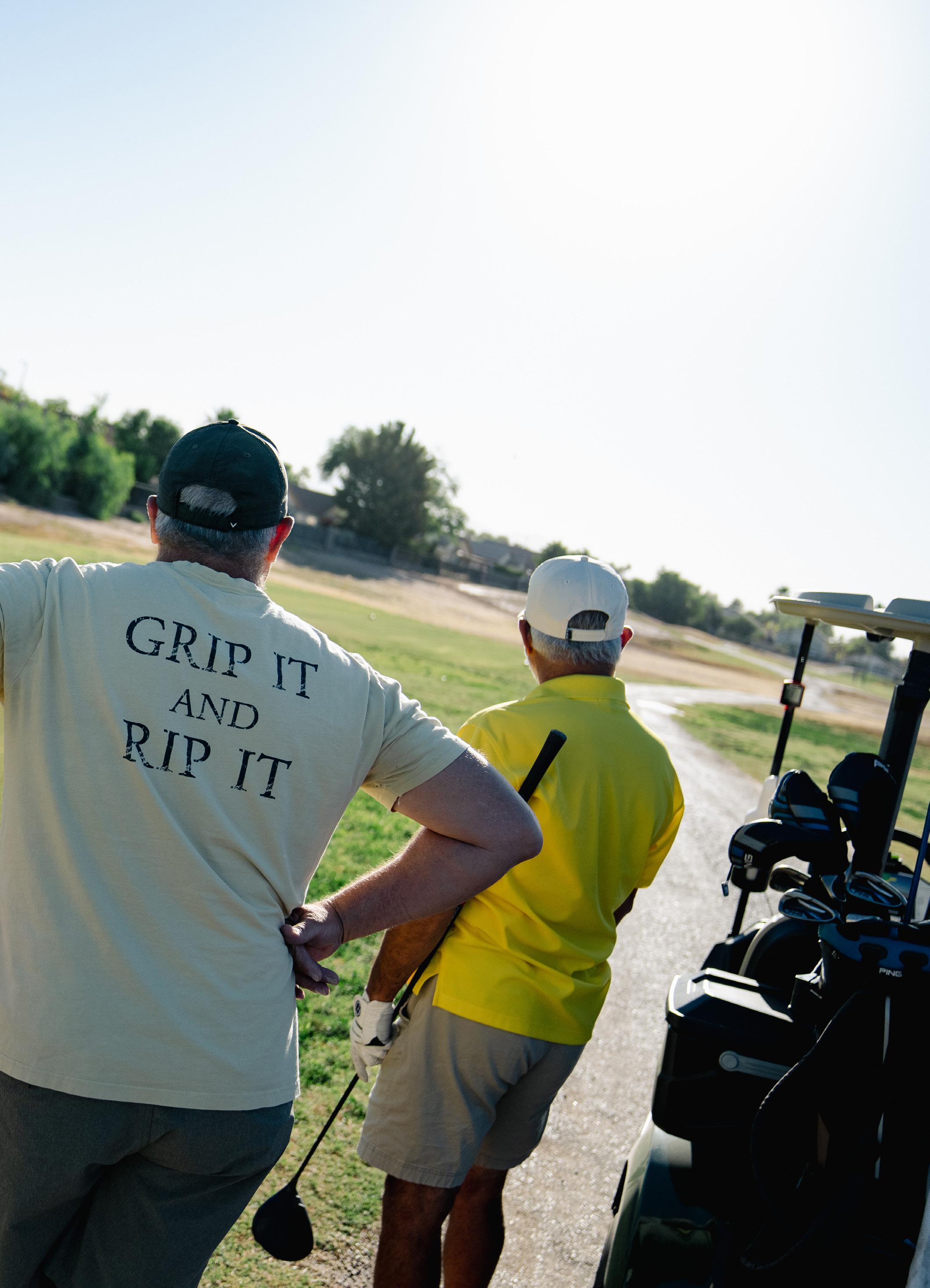
Sometimes he’ll stay for a drink in the air conditioning after he plays to help cool his body down. A regular day at the office.
And while summer golf in the desert is considered a feat by visitors and snowbirds alike, these desert diehards don’t think of themselves as some sort of special warrior class of golfer. They just want to play golf
Still, pragmatism is the rule of the day. Synthetic fibers, avoid alcohol (or manage it), and go have your fun.
“Pace of play and price — with so many deals in the summer — has really increased since COVID,” says Chris Quick, another Greenfield Lakes regular. “And when you’re really moving you don’t feel the heat as much.”
The low density of summer golf keeps him moving, and by teeing off late in the day and taking advantage of plentiful light, he can manage to squeeze in 36 holes.
Other golfers prefer early morning wakeup calls, some teeing off as early as 5:30 a.m. to beat the heavy heat. Quick’s primary rule is to know your limits.


“It can get pretty nasty pretty quick out here,” he says.
Another advantage to the summer is that, at Greenfield, when it’s not too busy, Quick and his friends play what they call cross-country golf, creating their own holes and turning some into par-sixes, making up new holes along the open corridors.
The key to maintaining this daily schedule of golf, though, may be one of climate.
“Believe it or not because the humidity is so low, you don’t sweat a lot,” Dan Zeal says. “As you are playing you’re not dripping sweat. It almost evaporates as it comes off you. I’ve drunk almost two gallons of water and never saw a drop.”
He delivers this information as if he’s just driven to the store to pick up tools for a home project without a trace of how insane it sounds. But then again, it’s life to him and other Arizonan golfers. The desert is the climate they chose, not the other way around. They are forged together — nearly literally — in the sun.



Ray is the outlier of the group in that he views summer golf as a test of endurance, his own personal Everest, deriving pride in the achievement of prevailing in a hot, midday round. He says he monitors his body and the heat baking his clubs, which can become skillethot if exposed for more than a few minutes.
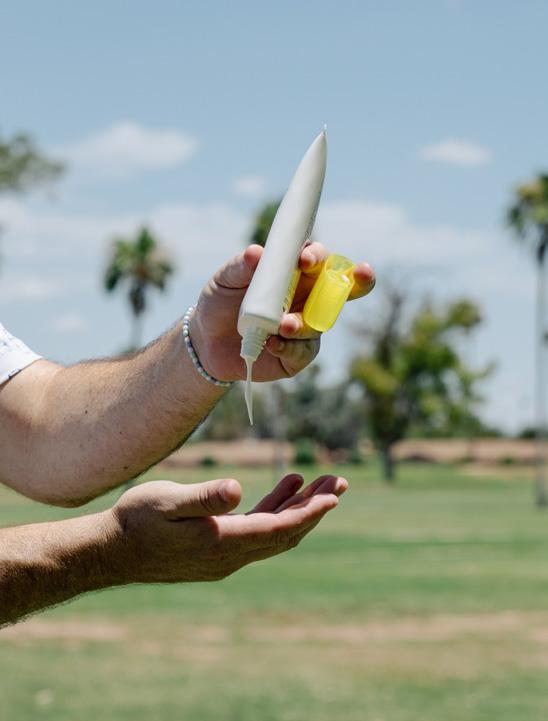
Playing well is nice but finishing is his prize, day-in and day-out.
But Zeal says the heat isn’t even on his mind.
“It’s going to be 106 today, and I won’t even think about it. It won’t feel like 106,” he says.

Similar to the desert, Arizona golfers are misunderstood. Summer golf is the price Arizonans are willing to pay to live in one of the nation’s top golf destinations. They don’t think twice about the heat; it’s just a part of life. Something they chose, all for the love of the game.




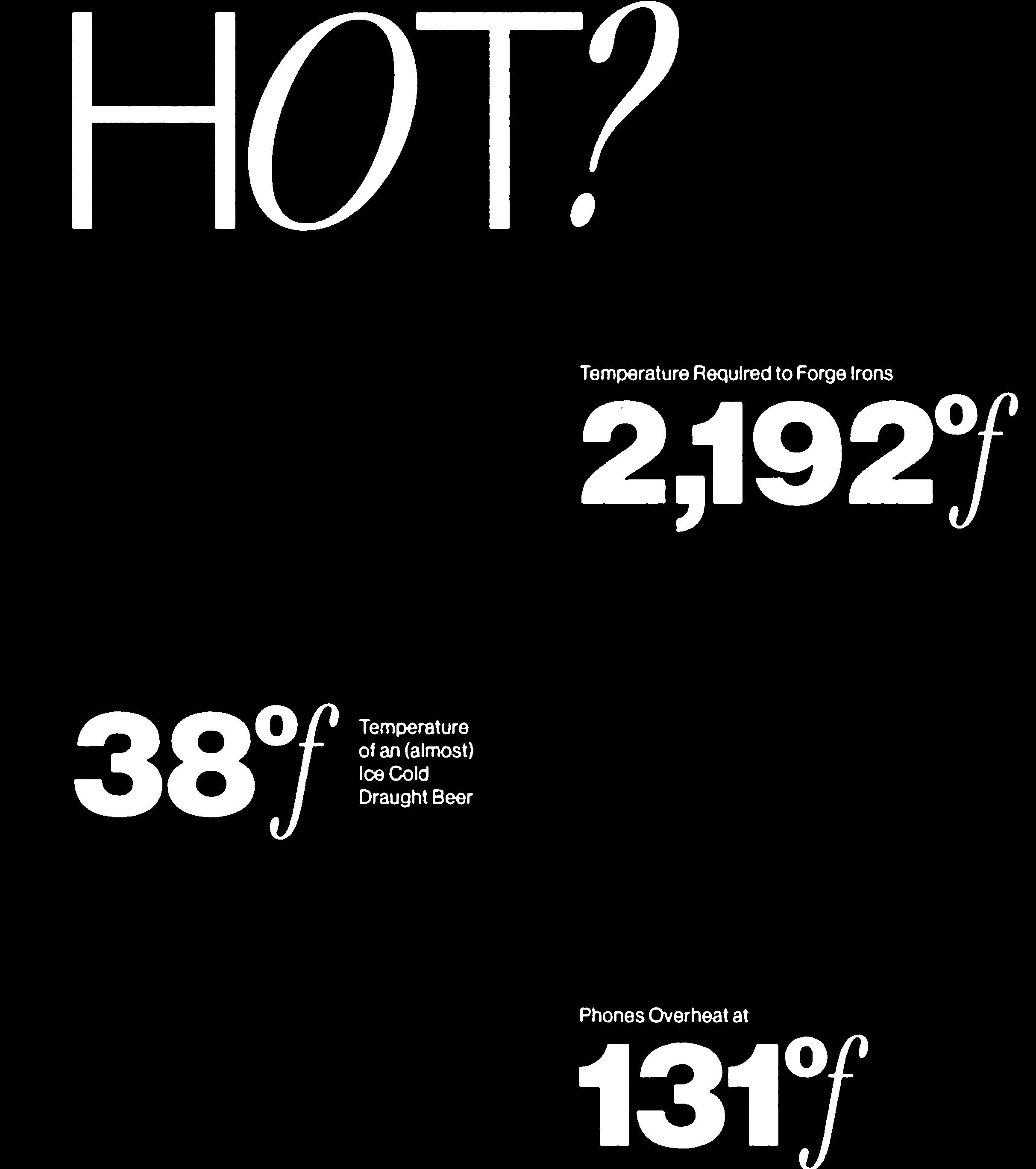
113131ºf



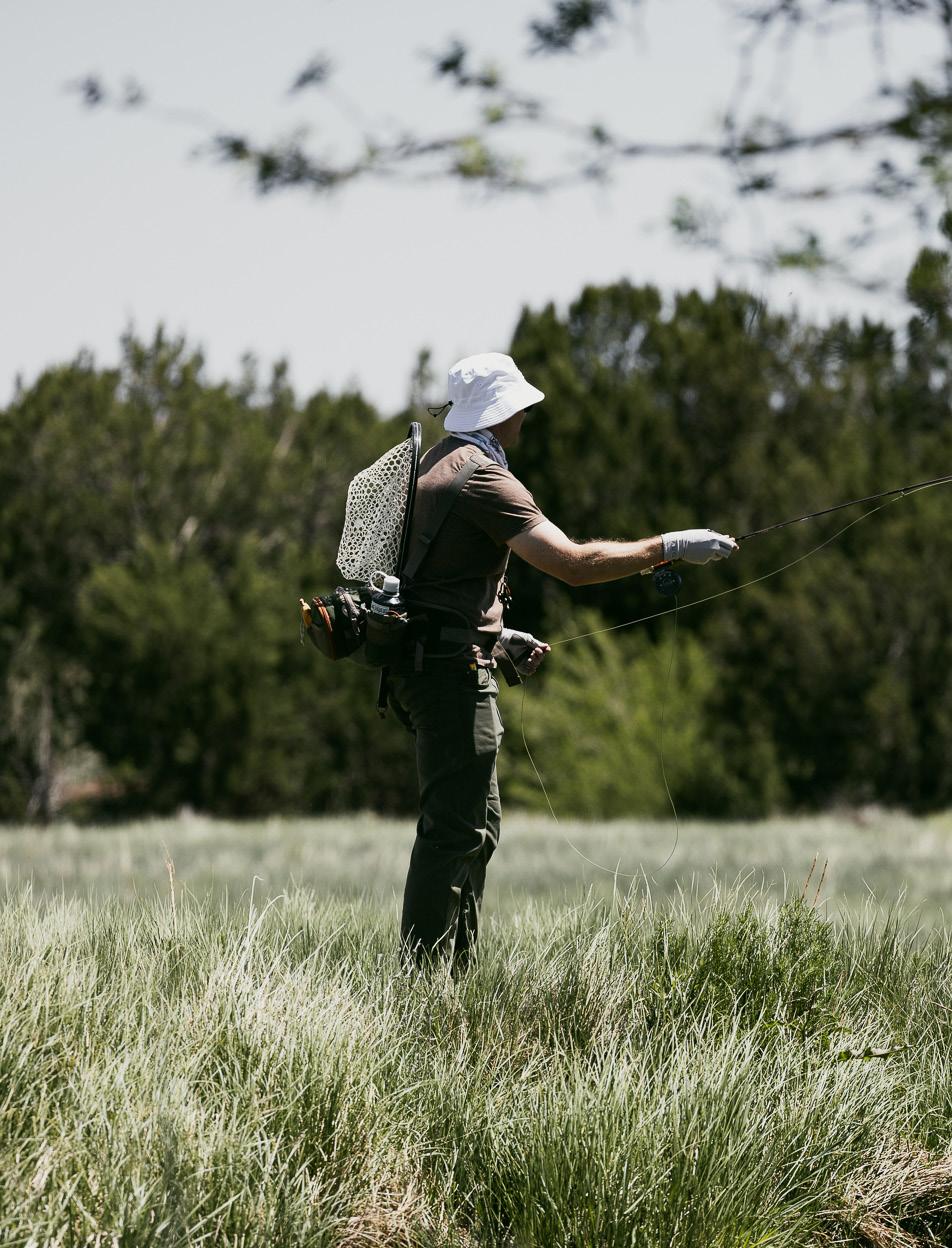
Photos by Preston McFarland
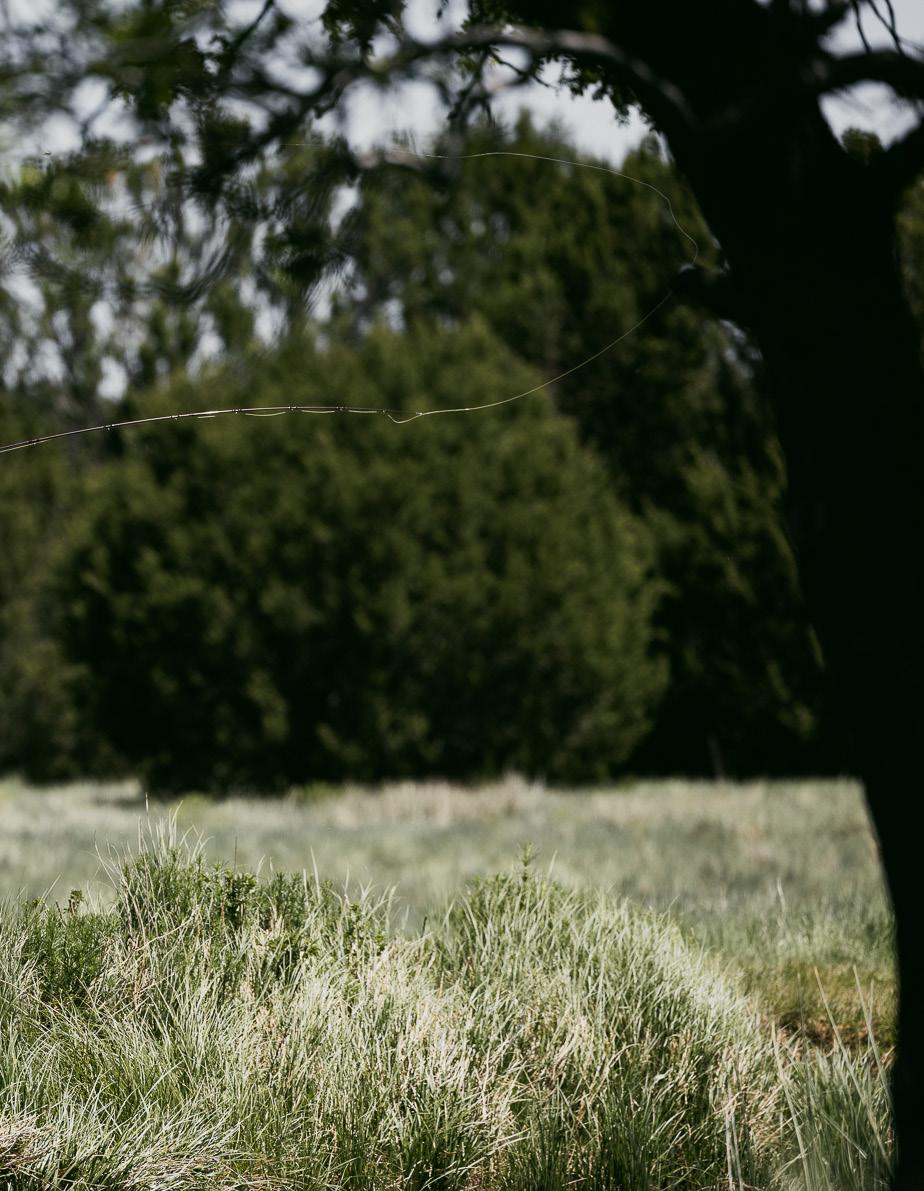
After a 3.5 hour drive, a roadside chimichanga accompanied by a margarita, and a stand up comedy special on Netflix, I parked my ass on the bottom bunk of a bunk bed in an Airbnb somewhere in Northern Arizona and closed my eyes.

Words by Jordy Barrett



THE NIGHT BEFORE 12:30 AM CAN’T SLEEP.

Endless thoughts raced through my mind as I restlessly laid there, predicting the beauty, the fun, and the obstacles that would present themselves the following morning. Like a ping pong ball, I bounced from sensation to sensation — from feeling the sun on my face to smelling the aromatic abundance of fresh air to concerns about negotiating presumably fast greens or wrangling a fickle-feeding trout in Silver Creek.
The anxious, tireless act of overthinking my day on the course or on the river the night before is normal for me. But my sensible wishes of achieving a good night’s rest were long gone. The fact of the matter is, the anticipation of playing golf and fishing on the same day is something I have dreamt about since I started fly fishing six years ago.
And right before I dozed off, I thought to myself, “How lucky am I (are we) to live in a state where doing both in the same day is possible?”
Welcome to Arizona, a true sportsman’s paradise.
THE NEXT MORNING AT 5:00 AM 450F


I woke up saturated with feelings similar to those I experienced on tournament days in college. You know ... That feeling where doing normal things, like making a cup of coffee, the morning before a round of golf somehow becomes more cumbersome?
As the sun began to eclipse the White Mountains, I pulled into Birdie Ranch Golf Club at Silver Creek.



5:45 AM
Low and behold, my tee time was pushed back an hour thanks to an unexpected frost delay at the end of May. Even at an elevation of 6,500 feet, that never even crossed my mind as a possibility.
If all I had on my agenda for the day was to play golf, then no biggie. But I had some Apache trout to catch, and like the rest of us, they feed at specific times of the day — and the menu might be different as the clock edges closer to noon.
In retrospect, silly worries. In both golf and fishing, the fear of imperfection and ghosts of past failures are always within striking distance. Just one intrusive thought can make your brain become scrambled, misguided, and less focused. Both sports are filled with the purest of highs and the most genuine of lows. A controlled chaos just waiting to be discovered sits somewhere in the middle, and IF unregulated, can impact decision-making and dust up a false sense of urgency.
7:00 AM 7:06 AM
It doesn’t take long to take note of the championshiplevel playing conditions at Birdie Ranch. Former owner and current General Manager Lloyd Harvey tells stories of the superintendent, Dalton, arriving at the course at 3 a.m. to make sure elk and other large high-desert wildlife are staying off the perfectly manicured greens.
The very first of Gary Panks’ 25 designs was less of a wide open links course than I expected. Peppered with an abundance of trees, bushes, and a few adjacent holes for errant tee shots, the Kentucky Bentgrass is artfully laid and meticulously maintained, transporting golfers into a unique and unassuming Arizona golf experience.
Plush fairways. Fast and pure greens. Not a blemish in sight. Not something you’ll find 3.5 hours south amongst bustling city streets in the heat of the summer.
The air, microdosed with the scent of juniper. The sounds, harmonized by the chirps of hundreds of birds. There’s a reason why Panks preferred to walk a round, which is exactly what I did. Immersed in the land, I knew I was about to have a day I didn’t want to end — and I was just getting started.
It was a daydream of an experience, and to top it off I hit a good ball down one. Approaching the turtleback first green, it was clear the green undulations were going to be the defense of the golf course. Seeing the beautifully sculpted curves made me a little bit nervous at first, as I envisioned the difficulty of navigating all the nuances.
If you’re unfamiliar with Panks’ work, he loves a drivable par-4 — and he didn’t make me wait long with the second hole, a 360 yard dog leg left. It was becoming clear the day was going to be a smorgasbord of golf holes, some drivable, some long and extremely challenging with narrow winding fairways and intimidating sight lines from the tee. A slightly exaggerated version of the challenges Panks usually gives us but set in a meadow reminiscent of Yellowstone. And I was there for it.
The rest of the round would be spent drinking in the perfectly framed views from the back tees, strolling the plush fairways, enjoying the turf interaction with the Kentucky Bentgrass, and giving the rolling greens my best effort.
The green speed and undulations mean you may need to land your ball 40 feet from the flag in order to have a reasonable uphill putt. An exciting challenge for someone visiting from Southern Arizona, where greens this soft and undulating are difficult to keep during the blistering summer.
Enveloped in the natural beauty and difficulty of the pristine conditions, I was left with little room for wandering thoughts. Conditions like Birdie Ranch build that rare excitement and feeling that “the time to play is now.” The feeling of liberation that only a summer road trip can bring.
By the time we hit the fourth tee I was completely immersed and thoughts of fishing after the round melted away.









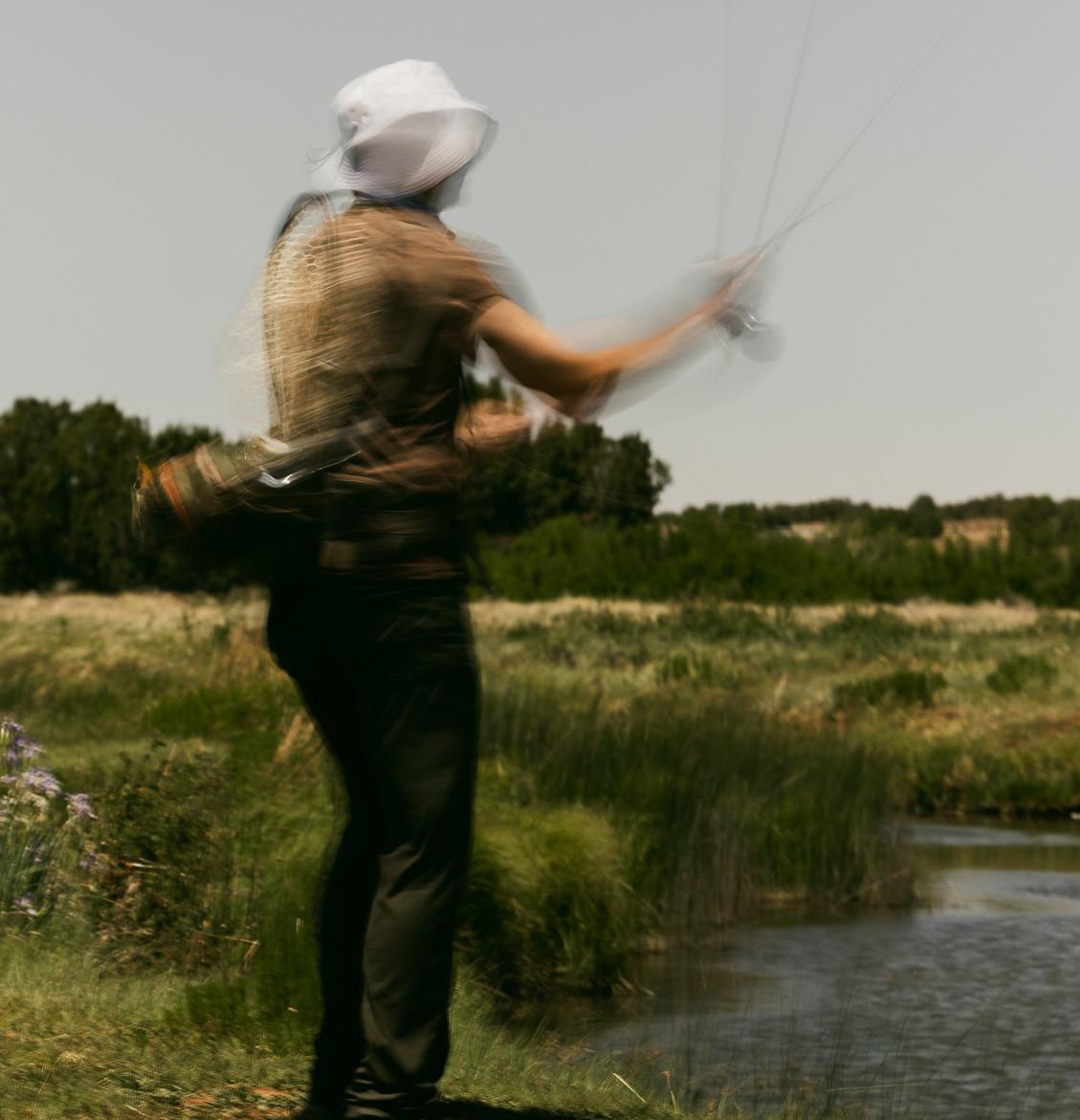
After navigating Panks’ artful green complexes and housing a half smushed PB&J sandwich I siphoned out of my golf bag, I was eager and hopeful that fishing Silver Creek would be a less challenging endeavor. It didn’t necessarily turn out that way at the beginning.
About two miles down the road from Birdie Ranch lies a narrow blue line stream that meanders through the tall grass of a meadow with an occasional Cottonwood tree impeccably placed at the bend of the creek to beg the question if Mother Nature is a cinematographer at heart.


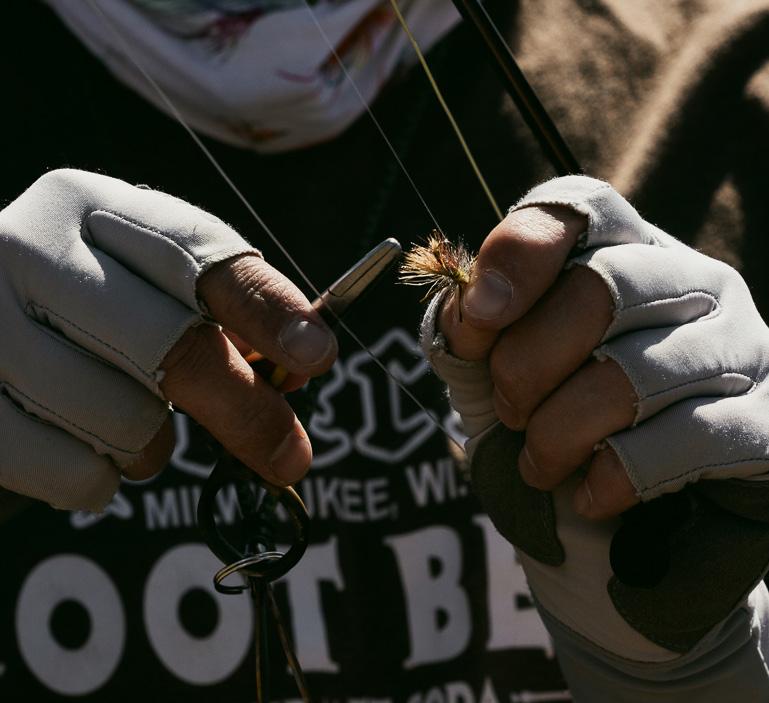

Close your eyes and envision one of those iconic “lone tree in a wide open pasture” scenes, like where Red found Andy’s note in The Shawshank Redemption, or where a cow chewing cud, who is followed by a rancher on horseback, might emerge from the desert at any given moment. The feeling of freedom and Americana that only small town USA can bring. A place where things make sense, the world slows down, and there’s time for the little things like shaking hands with an Apache trout. It’s a scene that makes you feel small in the world; a slice of Shangri-la.
Standing alone here almost makes you feel the rugged individualism it must have taken to settle the West.
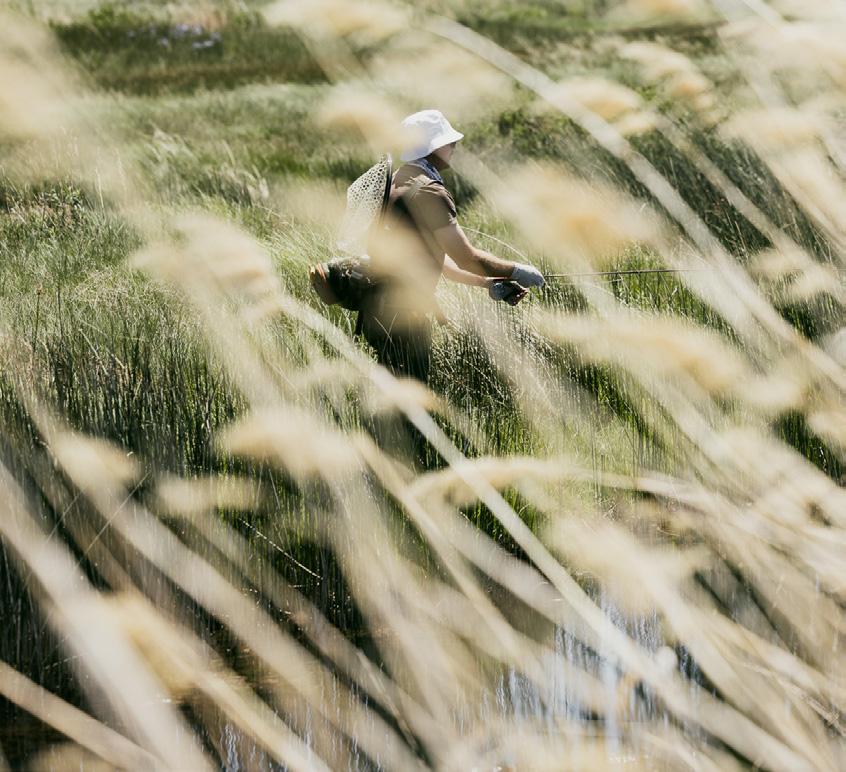
I pulled up to a vacant dirt parking lot and was pleasantly surprised to find that I was the only lunch break warrior on the creek. Things quickly changed … By the time I finished swapping my golf ’fit for my fishing ’fit and arrived at the creek rigged up with flies, other anglers began to show. It was, what seemed to be, a quick jaunt to the creek during a lunch break for the locals. What I had been planning for six years was a daily reality for dwellers of the Mogollon Rim.
As soon as I found my first section of the creek, another angler seemingly sprinted to a spot 20 feet upstream from where I stood. High hole’d. This is akin to a golfer standing over a tee shot while another golfer from the group behind walks up and rips a drive down the same fairway in front of you like it’s no big deal.
Another “frost delay.” It’s bewildering to me that both the round of golf and fishing session seemed to share a similarly inconvenient start.
To my surprise, the high holin’ angler turned out to be one of the nicest guys I’d met on a golf course or a fishing hole. Jerem was his name and he happily showed me what flies he was using and led me to a bountiful stretch of the creek. He handed me a fly he tied at home and then, before he meandered his way down the creek, giving me the highest position, he apologized for jumping ahead of me. A true class act.
I get how that excitement can cross wires in the brain. It’s happened to me in golf and fishing more times than I’d like to admit.
Locking in on that day’s menu for the trout proved more difficult than expected. At times, I’ve had enough success with stocked trout on certain flies; it gives me false confidence. It didn’t take many casts for me to experience the fleeting confidence that is everpresent in both golf and fishing.
After the trout passed on my fly selection I started feeling like Jean van de Velde on 18 at Carnoustie (especially after jumping in the water to retrieve some flies). This is where seeing another player have success can be helpful. If Jerem can catch these Apache trout, so can I.
I moved on from Jerem’s spot and carefully approached a hard-to-cast section of river with a fair amount of tall grass to artfully navigate my cast through. Similar to how the winds on the front nine at Birdie Ranch made finding the fairway with my tee ball a challenge, so would it affect my ability to cast my flies into this narrow section of Silver Creek. Luckily, in fishing, a bad tee shot doesn’t result in a direct bogey — unless you can’t untangle your flies from the river bank after the wind blows them off-course.
I watched my flies dart down in the water as only they can when grabbed by a trout. Setting the hook on my first Apache trout gave me mixed emotions — both anxious excitement and hyperfocus. After a touch-and-go start, I didn’t want to lose this trout before I got it in the net.
Hooking a trout is akin to rolling a pure birdie putt… and losing the fish before the net is equal to the worst lip out of all time.
I was enamored by the amazing colors gracing the Apache trout as I pulled it from the water, an experience that I still have trouble putting into words.
It’s almost impossible to describe the wonderment I felt as I briefly shook hands with one of the oldest living water-born creatures to still exist today.
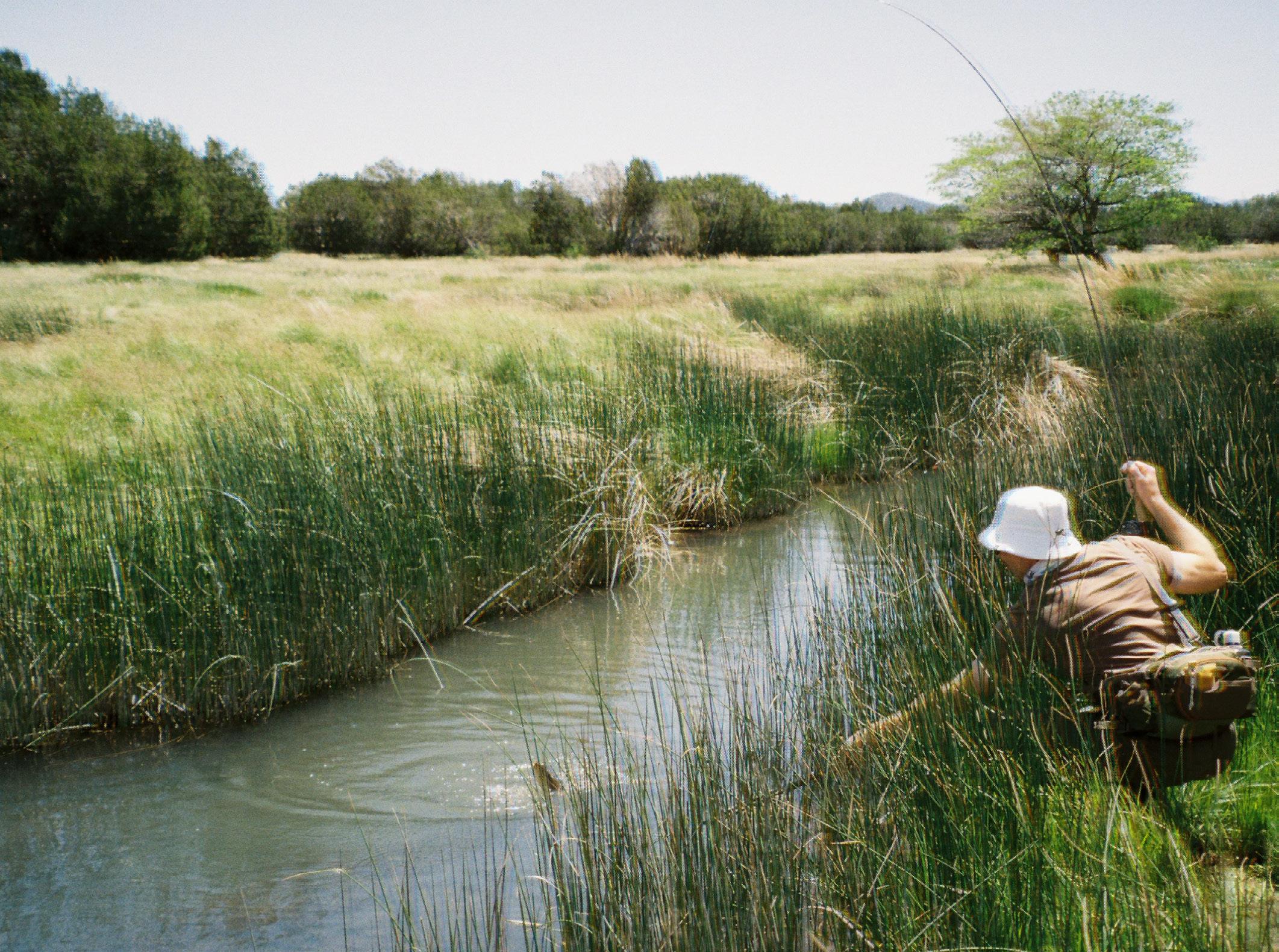


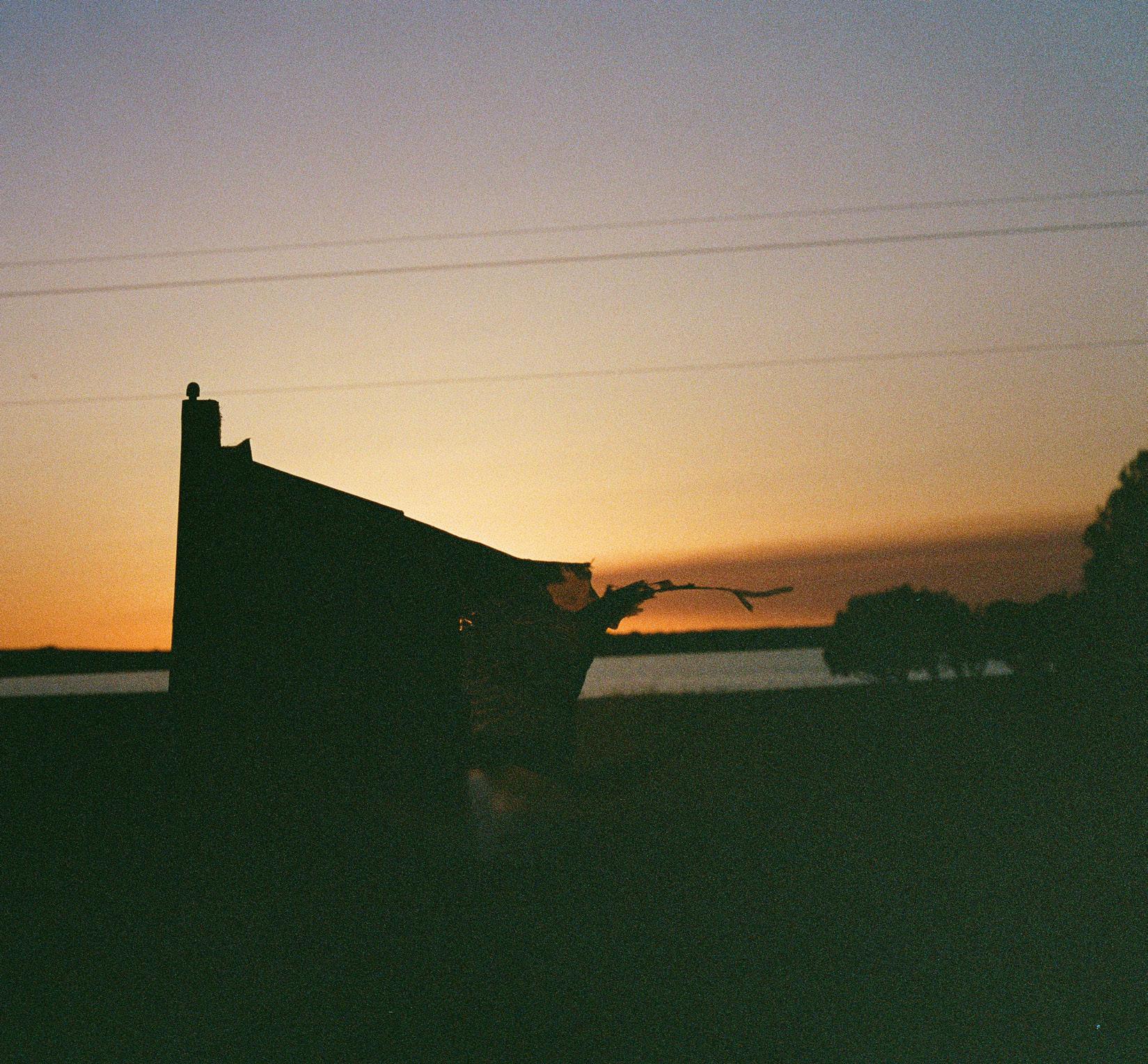
In golf, and in life, sometimes you get paired with somebody who rubs you the wrong way. But - if you can refrain from judging a book by its cover, you may end up meeting someone who helps you have the best day, or even more so, changes your life. It strikes me that both golf and fishing can create such anticipation inside of us that at times we act slightly out of character.
It also strikes me that both golf and fishing can take you to places that oftentimes aren’t on your bucket list, but provide a sense of escapism that can only be found off a mile marker exit.
Hooking an Apache trout after walking a round on a Panks design is like having two birthday parties on the same day; a true sense of wonderment and freedom that only an escape to smalltown America can bring.

I implore you to load your golf gear, fill up your tank, and hit the open road. Arizona is a true sportsman’s paradise brimming with unique experiences. You just gotta get there.

Jordan “Jordy” Barrett is a freelance photographer, videographer, and drone pilot focused on storytelling moments in golf. Prior to his freelance career, Barrett spent many hot summer days and chilly winter mornings working at some of Arizona’s premier golf course destinations. A scratch golfer and hobbyist fly fisherman, he is constantly enamored by Arizona’s beauty — both through the lens, and as a connoisseur of good golf and even better fellowship. To keep up with Barrett’s adventures, follow him on Instagram @goodjordy
click here to watch the Gol(f)ish short film

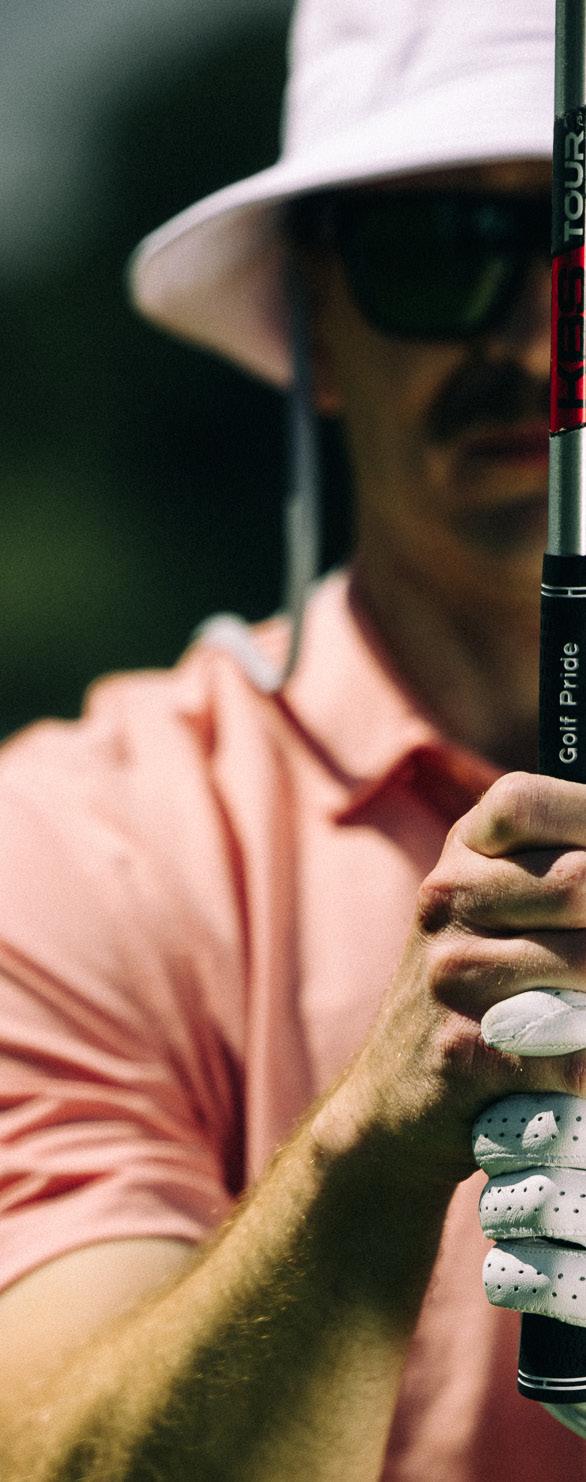



by


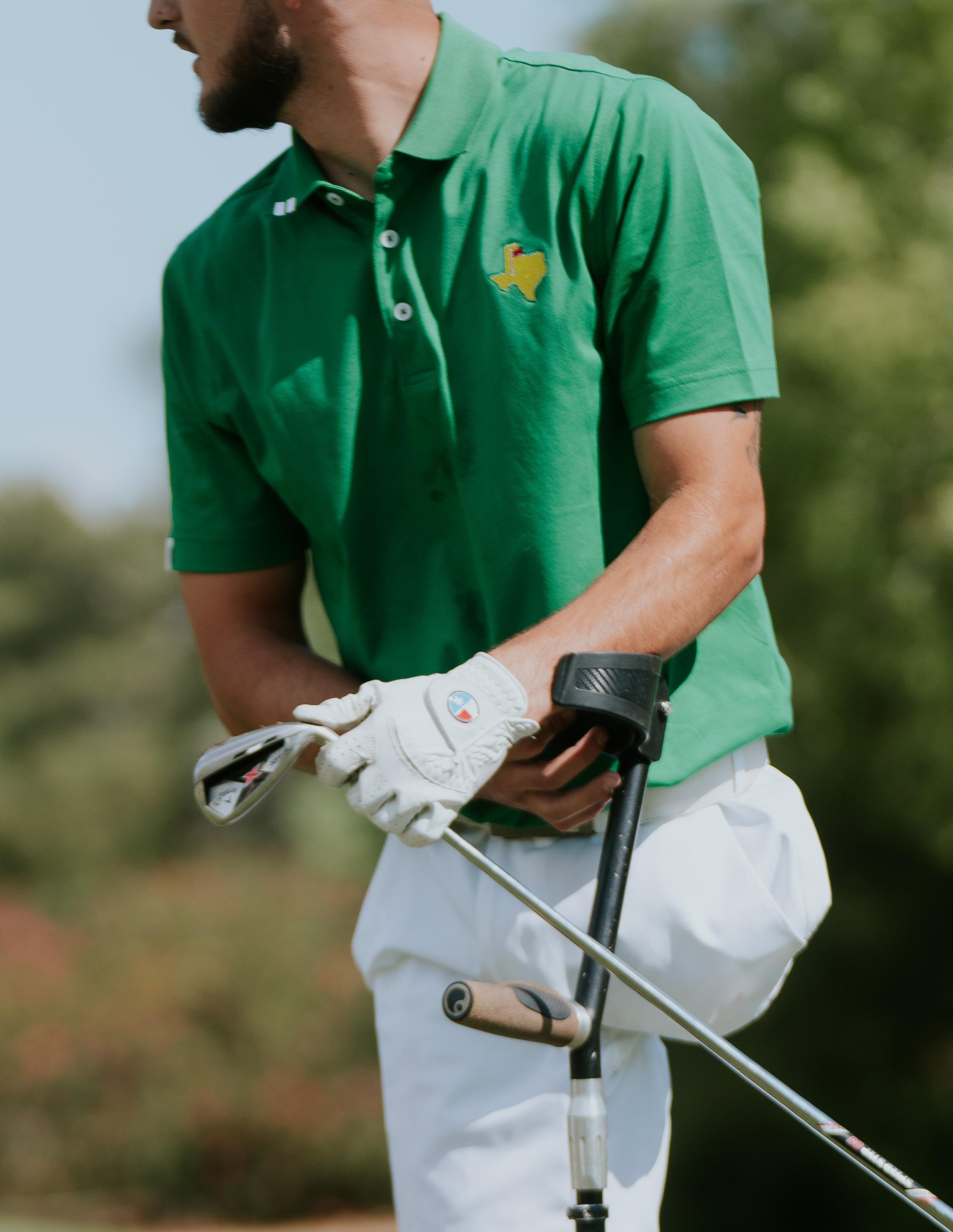

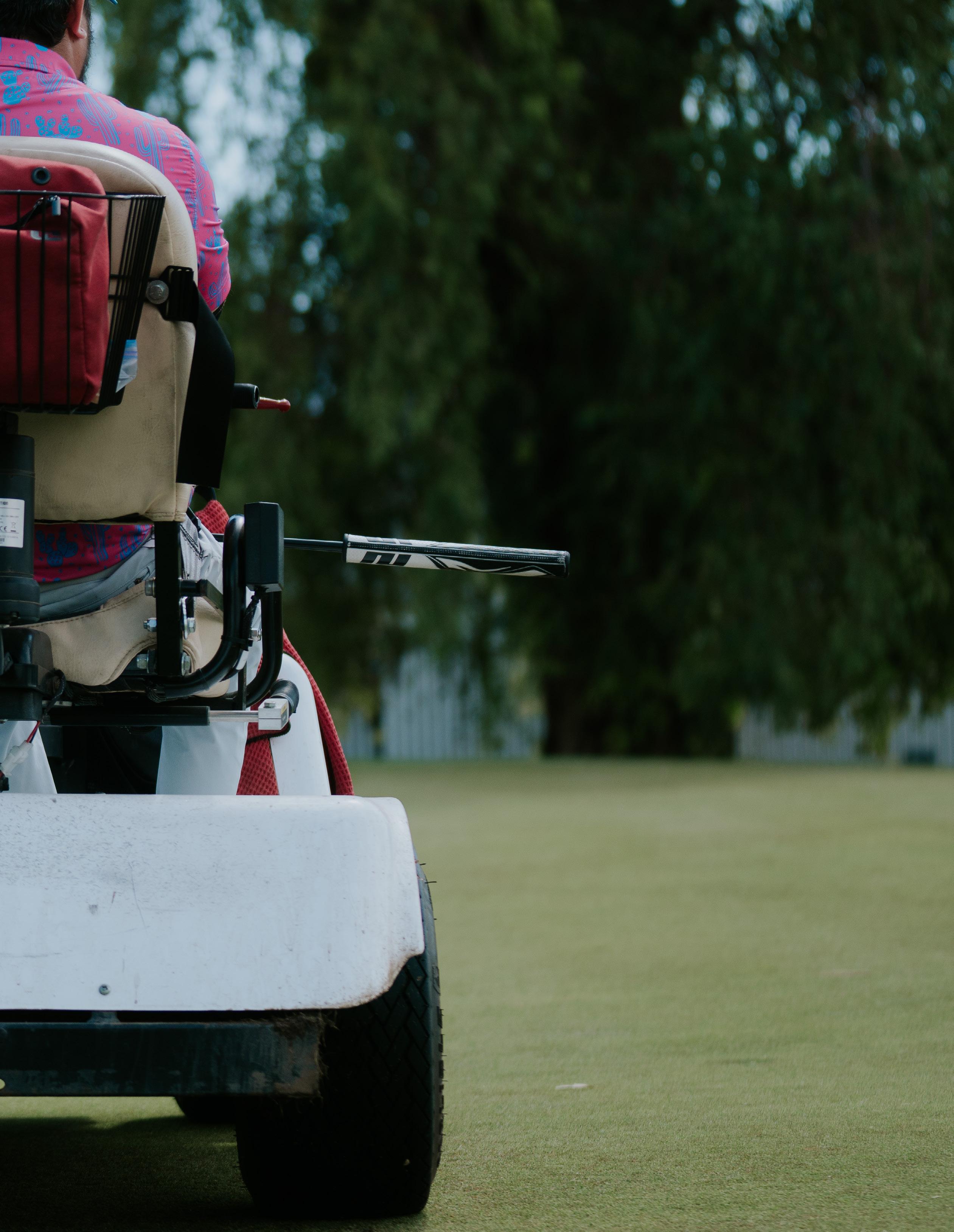

In 2017, the United States Golf Association (USGA) made a promise to the adaptive golf community to create a national adaptive golf championship. They followed through on their promise in 2022 with the inaugural U.S. Adaptive Open, and are currently preparing for the third U.S. Adaptive Open at Sand Creek Station in Newton, Kan. this July.
While the USGA worked out the logistics of a national championship, Georgia State Golf Association (GSGA) set precedent at the local level by running its inaugural adaptive championship in 2019, followed by the Florida State Golf Association (FSGA) in 2021. Those championships proved that adaptive golf championships can be well-executed at the local and national levels. They also raised the question for Arizona Golf Association (AZ GOLF) — why can’t they host one?
In another step toward inclusivity and diversity for all demographics of golfers, the AZ GOLF announced its inaugural Arizona Adaptive Open Championship. AZ GOLF’s newest championship aims to bring awareness to the sport and provide the first Association-run championship on the West Coast. The Championship is open to any adaptive golfer.
“As an association, one of our main goals is to create playing opportunities for all demographics of golfers. The Arizona Adaptive Open Championship is another opportunity for AZ GOLF to advance the game in Arizona and serve the adaptive golf community, which makes us better as an association,” Senior Director of Championships Logan Rasmussen says.
The inaugural Arizona Adaptive Open Championship will take place at Papago Golf Club from Dec. 9-11, 2024. The three-day event begins with an adaptive golf clinic on the 9th, followed by a 36-hole, stroke play championship on the 10th and 11th.
Golfers with physical and intellectual disabilities who have a Handicap Index® of 36.4 or lower are eligible to compete in the championship, and a full 60-player field is expected. An AZ GOLF membership is not required. Registration opens August 1st.

AZ GOLF kickstarted the conversation around hosting an adaptive golf championship last summer. Internal brainstorms around first steps led to outreach to several local, adaptive golfers via social media — many of whom had just played in the second U.S. Adaptive Open at Pinehurst No. 6.
That led to the formation of a dedicated committee to ensure that Arizona’s inaugural Championship is top-tier, while meeting the needs of participants. Frequent and candid conversations with members of the adaptive golf community have been vital to AZ GOLF’s preparation as they seek to provide an authentic golf experience while decreasing challenges for players.
Rob Walden, an Arizonan who is preparing to play in his third U.S. Adaptive Open, emphasized the importance of involving the adaptive golf community in the planning stages.
“If AZ GOLF is going to do a tournament, let’s do a great tournament. Let’s not start off mediocre,” Walden says. “One thing about the adaptive golf community is there’s a lot of word of mouth.
There is already a lot of buzz about Arizona having a tournament, so let’s take that, put on a good tournament, and make these golfers feel like they are a part of something that is special.”
Through discussions with the adaptive golf community and exposure to adaptive golf events, AZ GOLF is working towards implementing and adopting key elements that make adaptive golf events unique compared to traditional events. As would be expected, some of the more noticeable changes are on the course, such as shortening yardages and taking some bunkers out of play.

But other key elements are off-course. AZ GOLF is paying particular attention to hospitality accommodations, such as providing specialized restrooms capable of appropriately meeting the needs of players.
In addition to fostering relationships within the adaptive golf community, the AZ GOLF tournament team has immersed themselves in the world of adaptive golf by attending several adaptive golf events. Rasmussen and Championships Manager Everett Priddy are planning to attend the 3rd U.S. Adaptive Open Championship this July.
The goal of the trip is to gather insights and make observations at the highest level of adaptive golf to help guide decision-making, solution-creation, and ideation while planning December’s event.
“Until last year, I hadn’t really been exposed to adaptive golf at any point in my career. But going to clinics, interacting with the players, and gathering feedback has been crucial,” Priddy says.
“The players are our biggest resources and assets right now. If we see them struggling with something at any point in time, it makes us think about how we can avoid that at our event.”

AZ GOLF’s tournaments team has also worked closely with those who have experience running events, including Colton Dean, who oversaw the creation and execution of the GSGA Adaptive Open; he now works for the USGA as a championships manager, with a bulk of his work dedicated to the U.S. Adaptive Open. This year’s U.S. Adaptive Open Championship saw over 100 new player entries, as the USGA adopted a qualifying model for the event with qualifiers held in six states. Dean feels that it is essential for Allied Golf Associations (AGAs) to venture into adaptive golf, as it helps connect with new players who may not be aware of the opportunities available to them, while continuing to grow the sport.
“Playing opportunities are super key. There are probably a lot of adaptive players who we don’t know in Arizona who may not know about the U.S. Adaptive Open and it may be intimidating to go on that national level. Maybe it’s more difficult for them to travel,” Dean says. “Having these regional events and AGAs getting involved — like you guys are in Arizona — is crucial to keeping the momentum for adaptive golf at the AGA level. And all the AGAs are going to be a huge part of that mission to continue to grow this aspect of the game.”
Opportunities to play adaptive golf at this level are rare, particularly on the West Coast. For Bailey Bish, a seated golfer from Tucson who won the inaugural FSGA Adaptive Open, transporting her seated golf cart around the state for local events is doable, but moving it across the country is another story. If the tournament does not provide seated carts, her chances of playing are unlikely.
Adaptive golfers are accustomed to facing logistical challenges when playing in these events, but many of them found purpose in the sport and empathy amongst the community. As a result, they are willing to go to great lengths to play and better the game when they are called upon to give insight, like they were by AZ GOLF.
“The adaptive golf community is extremely tight-knit. We understand each other on a level that most people don’t get. We all have been through trials and tribulations that have been challenging and impactful to our lives. But we’ve all overcome that and use the game of golf to come together and find purpose after challenges,” Bish says.
Great consideration was also given to choosing a course that could meet the needs of the Arizona Adaptive Open Championship; several courses were considered, but Papago Golf Club emerged as the frontrunner. Papago’s centralized location, beautiful scenery, experience hosting major events (such as the Pac-12 Championships and AZ GOLF events), as well as its “open to all” mantra, made them the perfect choice to host the inaugural Championship.

AZ GOLF recognizes the importance of executing this tournament correctly, beyond merely checking a box for inclusivity. The bells and whistles of a traditional major championship are not necessarily expected by adaptive golfers, especially at independent local tournaments, but AZ GOLF is working diligently with its partners to curate a successful and memorable event.
Walden has been involved in several adaptive golf tournaments, both as a player and an advisor. He has been a part of many great tournaments, but he has also been a part of tournaments where organizers disappointed players by over-promising and under-delivering.
“We’re all training to do this and be able to play our best and I think AZ GOLF has the right attitude. They’re going to tournaments. They want to see what’s working for other sites and making sure that they’re going to give a quality product,” Walden says. “And like I said from day one, if we weren’t going to do that, and we were just doing it so that we could say that we had an adaptive golf tournament in Arizona, I wasn’t going to be involved with it. I want to put on something that’s special.”



The success of the Arizona Adaptive Open Championship relies heavily on community support and involvement. Volunteers are especially crucial at this event and various opportunities will be available. Sign-ups will be open on August 1st. For more info, contact Peg Tanner at peg@azgolf.org
AZ GOLF is currently seeking partnership opportunities and activations for the Arizona Adaptive Open. If you are interested in a partnership opportunity, please contact Preston McFarland at preston@azgolf.org. Partnership outreach has begun.
Those who wish to donate can fill out the donation form. Donations will be sent to the Arizona Golf Foundation, AZ GOLF’s 501c3 charitable arm, and utilized towards the event.
All monetary donations will be sent a statement at the end of 2024 should donors want to utilize contributions for tax purposes. We can also supply individuals or corporate donors who donate goods and services a letter for tax purposes as well. Thank you for your generosity and please reach out to Daniel Shoup, our Head of Finance and Administration with any questions or special requests (daniel@azgolf.org).
by Michael Williams


Words by Georgann Yara







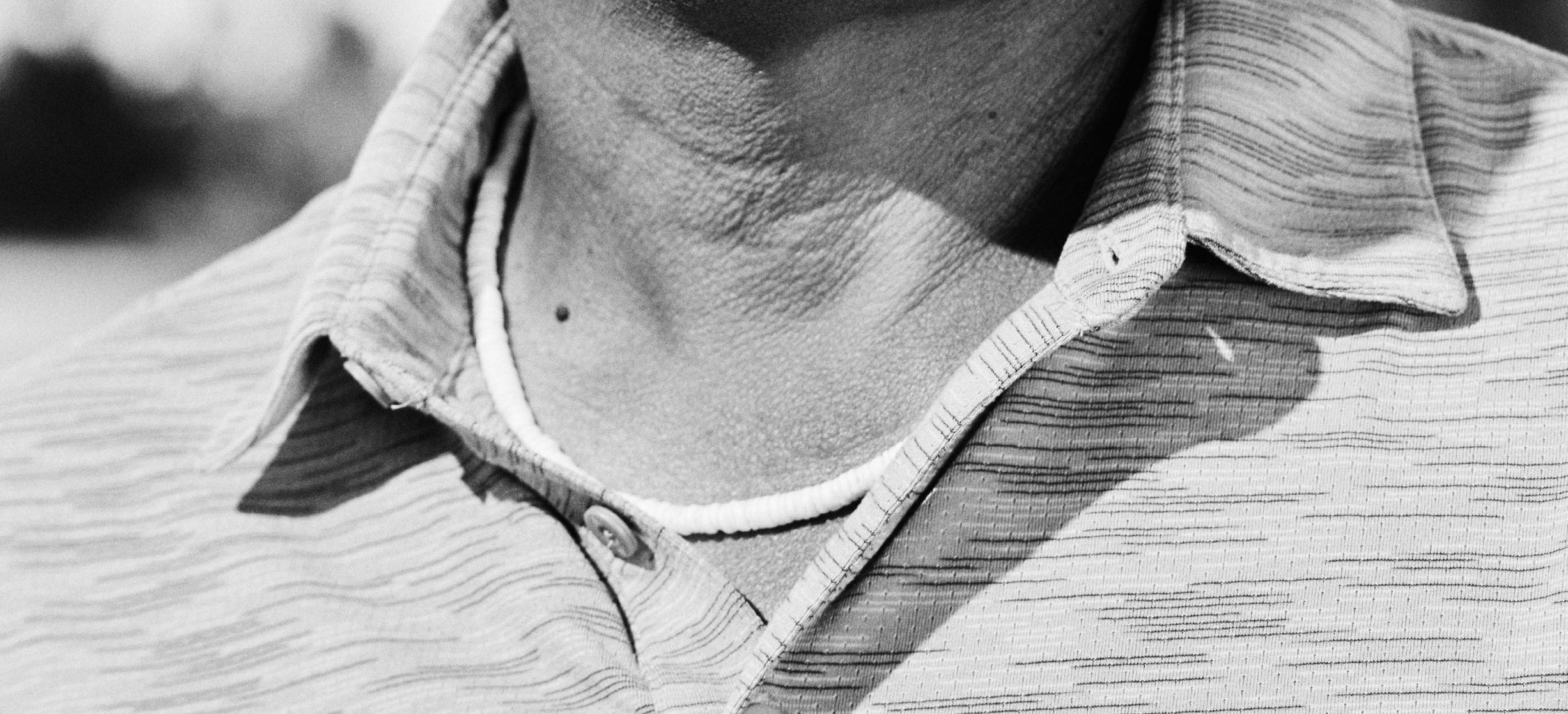
MCC head golf coach John Guerrero has led both men’s and women’s teams to stratospheric heights.
...but his true success lies beyond titles and records.
To say that John Guerrero is having a historic run as the head coach of Mesa Community College’s (MCC) golf program would be a massive understatement.
But if it weren’t for Guerrero’s passion for hitting another kind of ball — and not with a club — MCC golf and the lives of hundreds of student-athletes would not be the same.
While he was growing up in Mesa, Guerrero’s father was a faithful supporter at his Little League games. However, occasionally he’d be absent in the crowd on weekends.
“Like any other kid back in the day, I was my dad’s shadow. I wanted to do everything like my father,” Guerrero says. “As soon as I found out what my dad was doing on the weekends — playing golf — I wanted to spend more time with him.”
At the age of 12, Guerrero picked up a club for the first time. And at that moment, the future of Arizona’s collegiate golf space was forever altered.
Since taking the head coaching reins at MCC, first for the women in 2001 and then the men in 2005, the MCC Thunderbirds have won dozens upon dozens of Arizona Community College Athletic Conference and National Junior College Athletic Association Region I titles, tournament qualifications, and Top 10 finishes.
Starting with his first season as the women’s coach, the team went on to win 17 of the next 18 Region I titles, and at one point, captured 83 consecutive conference tournaments over a span of 12 seasons.

Guerrero himself has garnered 21 ACCAC Coach of the Year awards and mentored 39 All-Americans, 81 All-Conference, and 65 All-Region student-athletes in the span of 23 years. In 2014, he was inducted into the NJCAA Women’s Golf Hall of Fame, and in 2023, his alma mater MCC inducted him into its Hall of Fame.
“I look at it year-by-year, not as a decades-long career,” Guerrero humbly confesses. “I look at it as ‘what do we do to be good now.’”
As a kid, it wasn’t long before Guerrero was trading baseball cleats for golf spikes, leather mitts for leather golf gloves, and balls with laces for balls with dimples. And it all started with a desire to be just like his own dad.
“He gave me a club and everything made sense,” Guerrero recalls. “The challenge of the game, the competitive part about it, it just made sense to me.”
Guerrero proved to be a natural. That same year, he started competing in the Junior Golf Association of Arizona (JGAA) and excelled. During this time, Guerrero met someone who taught him how to harness his gift, while sparking a competitive edge that propelled Guerrero above the pack.
The late Louis Bustillo was the assistant golf pro at Shalimar Golf Course, where Guerrero played in his youth. Bustillo got him involved with the JGAA so he could play with golfers his own age. Bustillo was also known for bringing pros around and testing his students against the best in the world.
“He got me into that competitive drive by playing against each other and trying to beat the pro,” Guerrero says.
Guerrero graduated from Westwood High School, where he was the #1 player on the golf team in his junior and senior years. He went on to demonstrate the same acumen on MCC’s golf team. He turned pro and joined the staff at the former Riverview Golf Course, now the location of Sloan Park, and became an instructor at Dobson Ranch Golf Course, a job he maintains today.


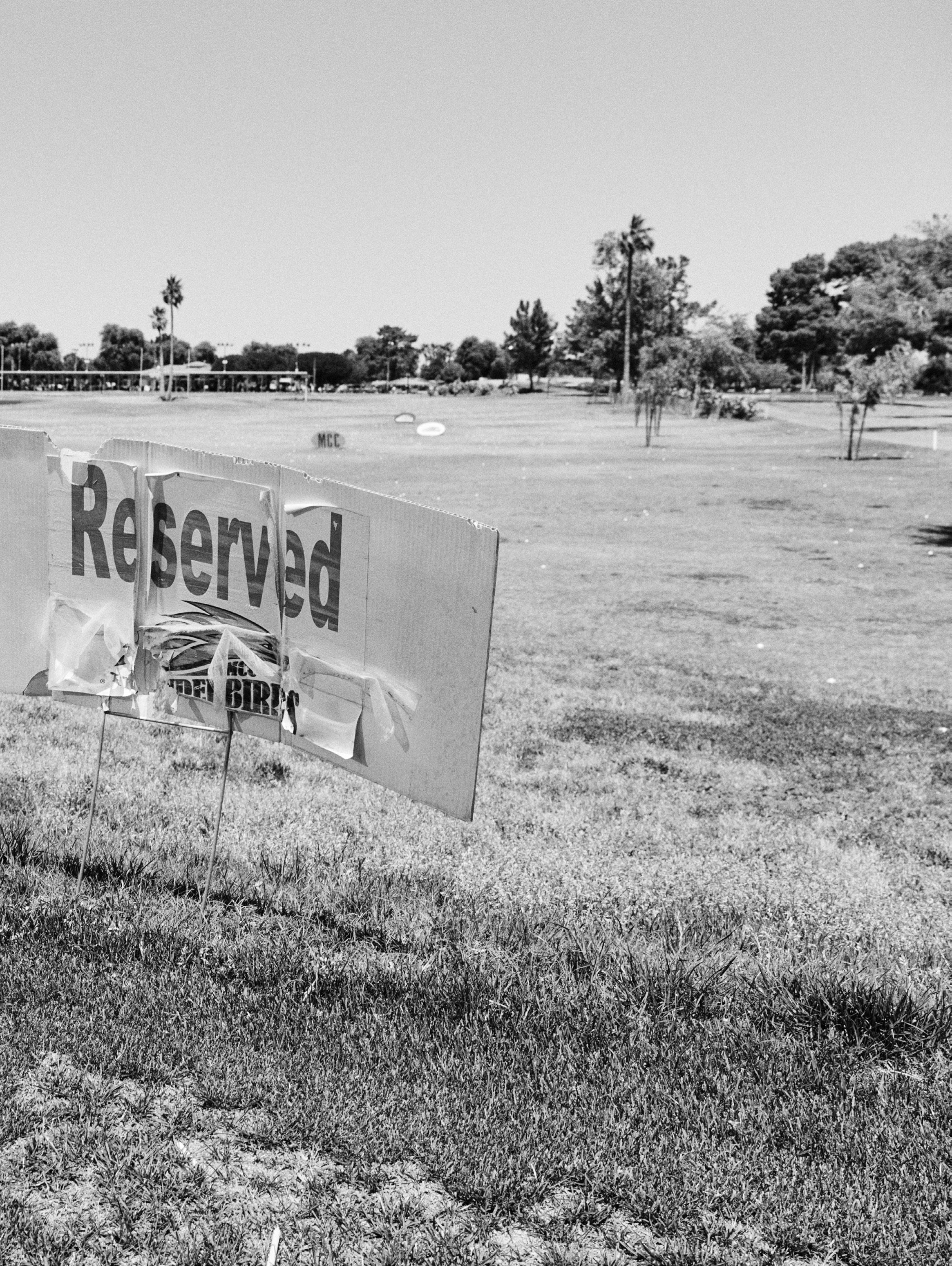
Guerrero is one of the most lauded and perennially successful college golf coaches in Arizona, with a slew of titles and awards to back it up.
And somehow, he has managed mostly to stay outside of the who’s-whoof-Arizona-golf spotlight. Part of the reason could be because Guerrero doesn’t even register on his own radar. His surprise to his 2023 Outstanding Coach induction into the MCC Hall of Fame is a prime example.
The only person he told about the honor was his wife. When he saw a crowd of people from various points in his life at the ceremony, he asked them what they were doing there. The word had spread.
That doesn’t surprise Guerrero’s former student Erin Groeneveld, whose parents were among that crowd.
“Yeah, that’s him,” Groeneveld says with a chuckle. “That’s John.”
However, Guerrero’s relationship to the sport that has become a major part of his 52 years extends beyond statistics, accolades, and awards.

He and his teams adopt families during the holidays, assist in junior golf tournaments, run golf clinics for underprivileged youth, and support Special Olympics golfers. He volunteers at junior golf camps and works with special education students at Westwood High School, his high school alma mater.
He connects with players through humor, compassion, and even music. He’s been known to load the van playlist with every player’s favorite song to pump them up on the way to matches.
“I live my life in a way where I try to think about today and make good choices today,” Guerrero says. “If you surround yourself with good people, good things will happen. If you work hard, good things will happen.”
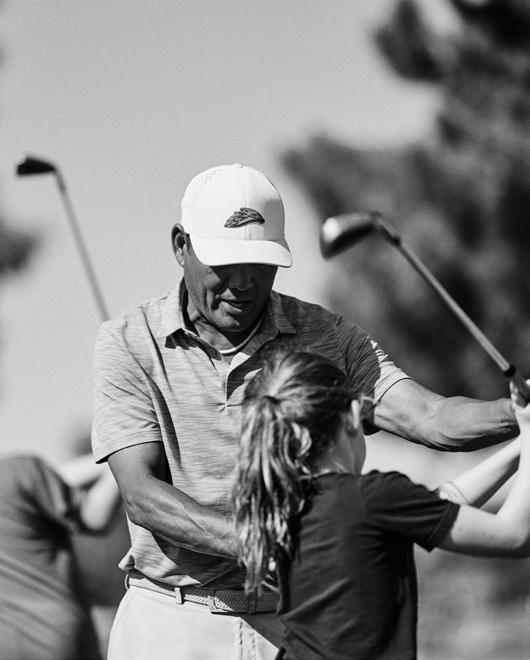
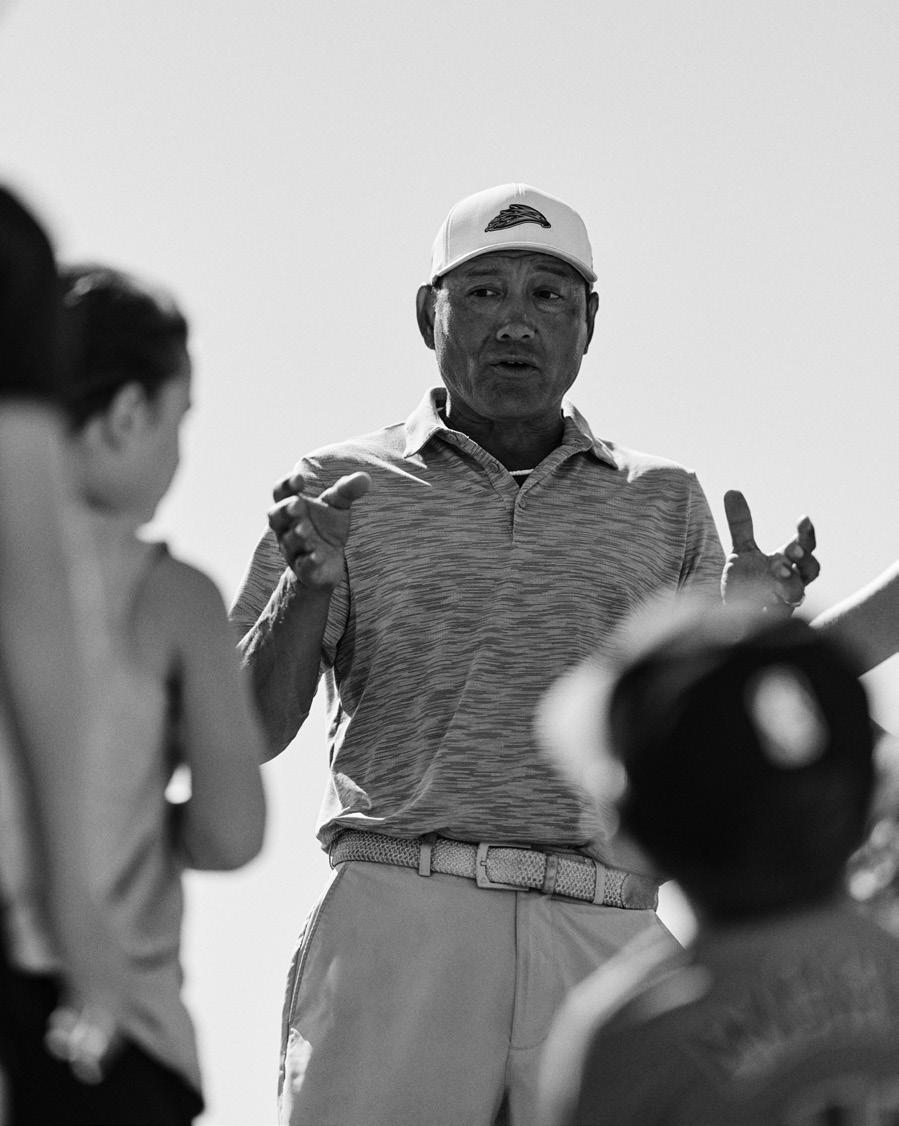

Like many of Guerrero’s former players, Groeneveld went on to have a successful golf industry career.
After being a top player on the team from 2002-2004, Groeneveld held manager and director posts at the Arizona Women’s Golf Association, Arizona Golf Association, and Florida State Golf Association.
In her current position as regional affairs director at the United States Golf Association - Northeast, Groeneveld gets calls every couple of months, mostly tournament rules questions, from her former coach.
Guerrero’s passion for the sport, dedication to players, and knack for being completely relatable to everyone on and off the course was a huge influence on her professional journey.
“Seeing the amount of joy he got from being a coach and being around the game really helped me make the final decision to shift my path and pursue golf administration,” Groeneveld says.
Alex Trevino played for Guerrero from 2014-2016 and was on a men’s team that was ranked as high as #2 in the nation. As a member of the team, Trevino assisted Guerrero at free golf camps and clinics for youth.
This instilled the value of giving back and mentoring the next generation of golfers. Guerrero brought Trevino back to MCC as an assistant coach for three years, which piqued Trevino’s interest in coaching youth on a more serious level.
“It opened my eyes up to what it’s like preparing the higher caliber player,” says Trevino, who is the lead instructor at Elite Golf Schools of Arizona. “He’s very much been an advocate for junior golf. You always hear them say, ‘You’ve gotta grow the game.’ He does that by making sure it continues to grow and flourish.”




His deep involvement with junior golf and ability to connect with kids and their parents are qualities Guerrero inherited from his late father Ted, a 33-year veteran of the U.S. Postal Service.
“My friends used to come over a couple of hours early just to have conversations with him,” Guerrero recalls.
While in college, Guerrero worked for what is now the East Valley YMCA. He then went on to work for school districts’ summer programs. And in 1993, the Madison School District in Phoenix reached out to Guerrero about starting a summer golf class, to which he obliged. The class proved to be successful and became the Madison Golf Academy, which Guerrero ran for seven summers.
The desire to teach the game to as many young players as possible is a driver behind Guerrero’s volunteer work, although he doesn’t view it as such.

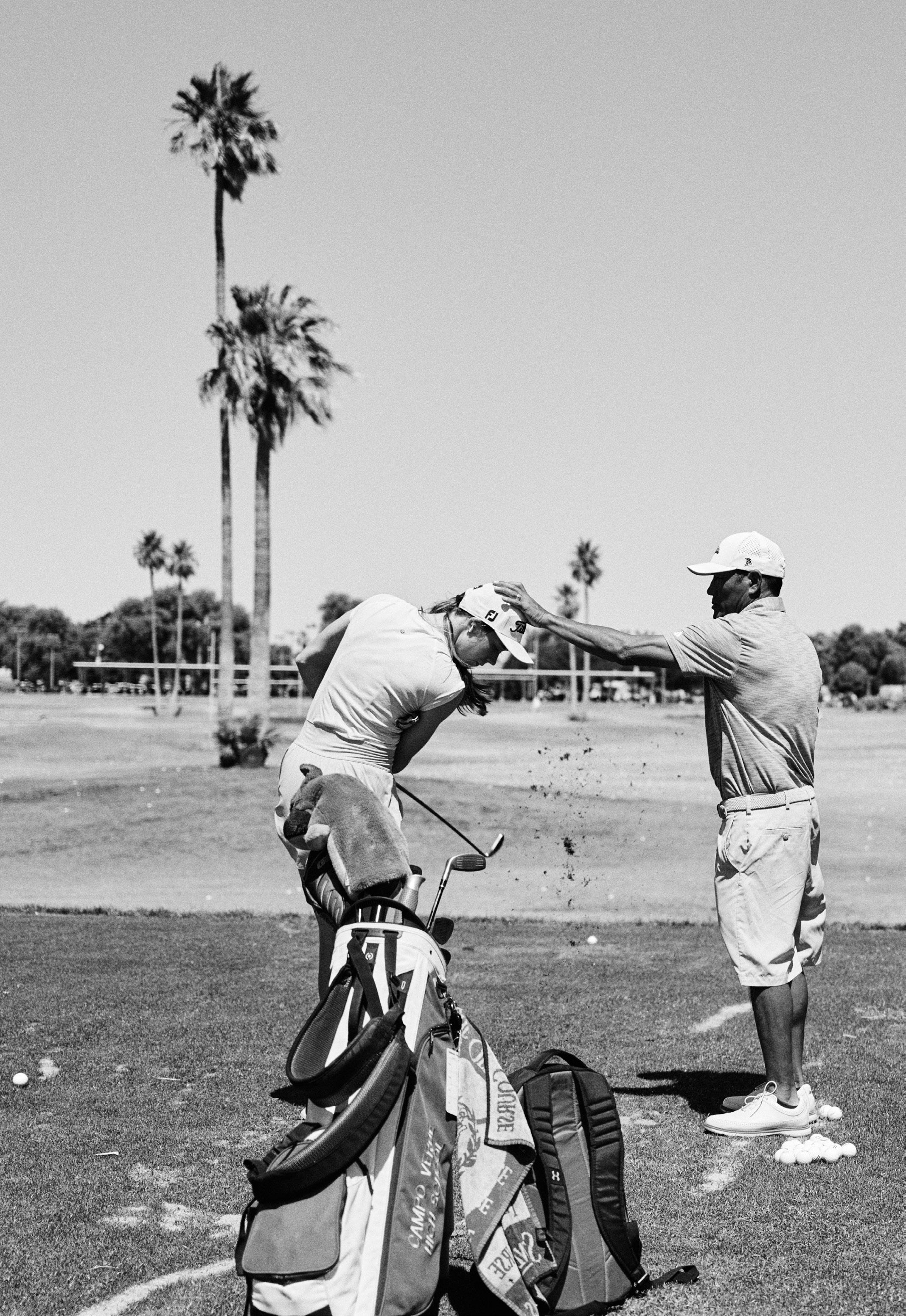
“I don’t look at it as volunteering. I look at it as doing something I enjoy,” he says.
When Cheyanne Stewart, lead junior instructor at Dobson Ranch Golf Club, launched the program that offers free golf clinics and workshops for kids, she was new to coaching. She asked Guerrero, for whom she played from 20162018, to help.
“With him coaching the juniors, he gets to know their names, he’s cracking jokes…,” Stewart says. “That’s more memorable than the shot itself.”
For some, this is their only opportunity to experience the game. So Guerrero makes it count. He tirelessly reaches out to organizations to donate equipment or other resources.
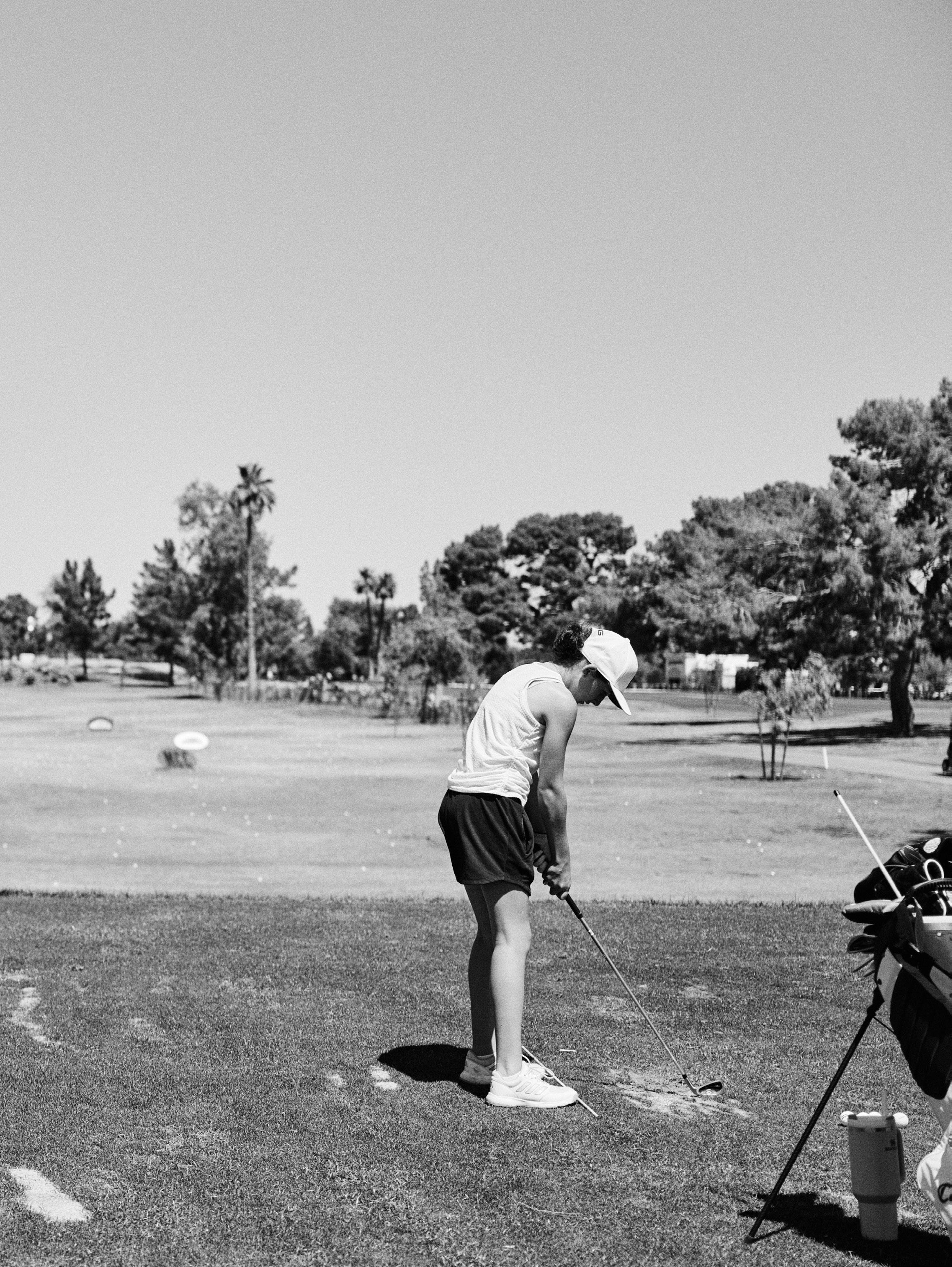

“They may have access to basketball or sports where they don’t need as much equipment. Golf, you need help with that,” he says. “We’ve introduced the game to kids who otherwise wouldn’t be introduced to it in their lifetime.”
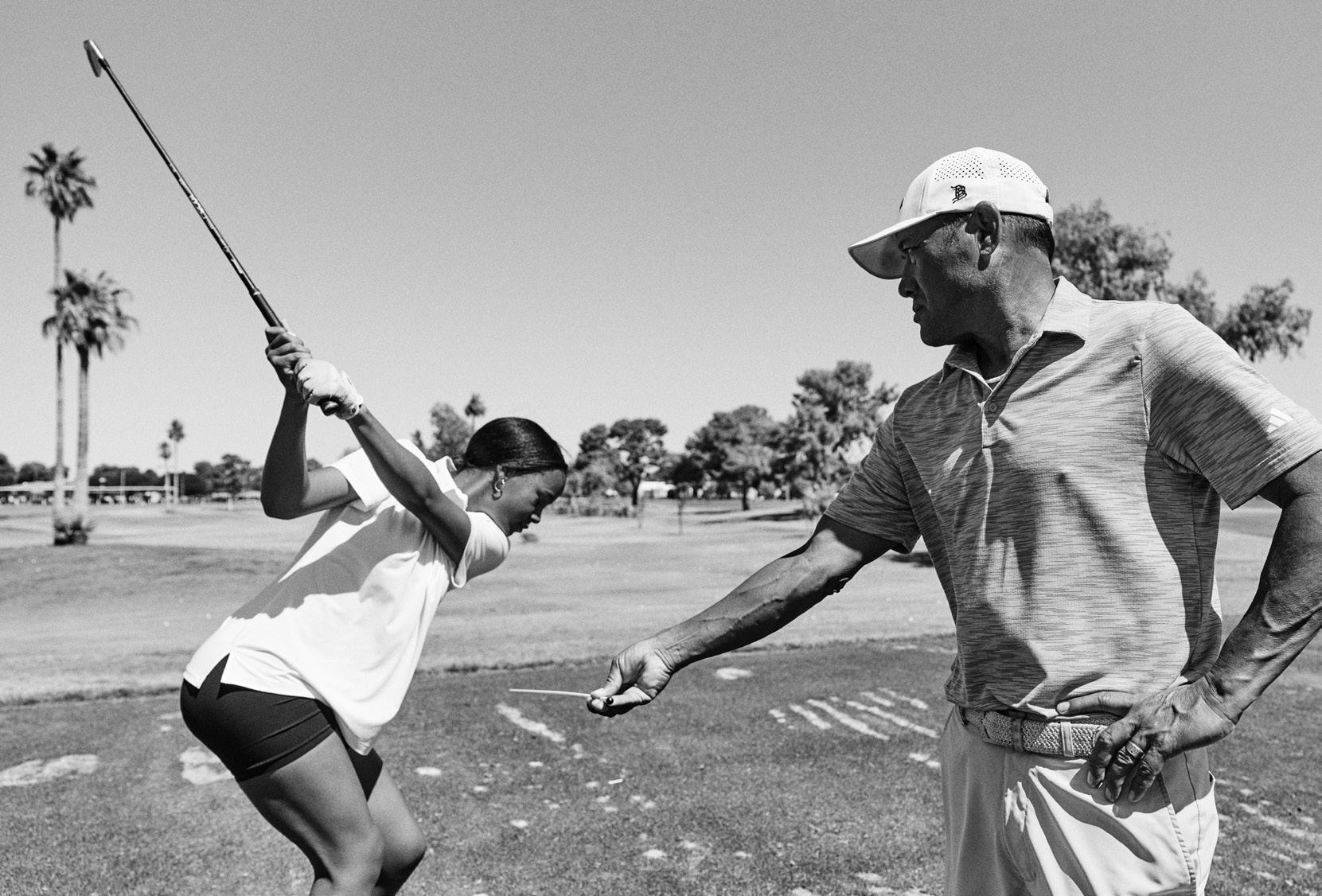
When MCC Director of Athletics John Mulhern arrived at MCC in 2012, the golf program’s success had been more than adequately demonstrated.
From a collegiate standpoint, Mulhern addresses Guerrero’s impact on two levels. The first is measured in the sheer number of championships, tournament titles, and All-Americans that have graduated under his watch.


“It’s incredibly impactful for the college overall and for the success of the athletic program,” Mulhern says.
“This is the only job John has had here. His longevity proves his commitment and at any college, when you have that longevity in a program, you’re almost always going to have success.”
The number of players who return to visit Guerrero represents a second, less tangible factor that was instrumental in his Hall of Fame honor.

“When student-athletes come back and say, ‘Hi, Coach. I saw your success,’ you can tell that’s a good program,” Mulhern says. “He’s committed to golf. He’s always working to grow the game, to encourage youth to take up the game. That’s someone who is in it for the long haul.”

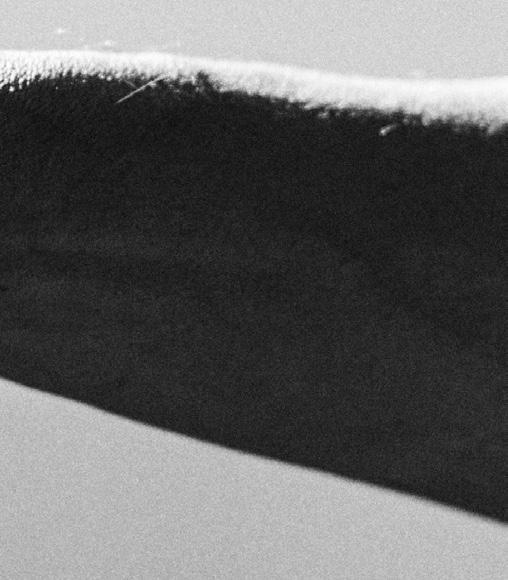




Guerrero’s reputation as a jokester, and a father-like figure for his players, is ubiquitous among those who’ve spent any significant time around him. They say this is an asset.
“With his personality, he has a way of connecting with people,” says Meghan Dunigan, one of Guerrero’s first students and part of the MCC team from 2001-2002. “He gets to know you and uses that to connect with you and know how to coach you.”
Guerrero has also coached her daughter, who is now age 13, for three years. A high school teacher, Dunigan coached girls golf at Basha High School for eight years, modeling her approach to coaching after his.
“He makes you feel comfortable making mistakes as you’re learning the game. But he’s also very straightforward. He tells you what you’re doing wrong but you don’t feel bad about it,” Dunigan says.

That’s not the only way Guerrero makes his players feel comfortable and confident.
A late bloomer in the sport, Stewart didn’t start playing until the end of her freshman year and knew she had to work hard to make up for lost time.
One summer, she was on the range during the hottest time of day. Guerrero passed her at the turn and when he completed the 18th hole, she was still there hitting balls.
Guerrero asked the pro shop guys if they knew who she was. They did, and Guerrero called Stewart that night, wanting to meet with her and her father.
Like usual, Guerrero’s instinct about players was right. Stewart would become part of a team that went to nationals twice.
“He really loved the work ethic I had,” Stewart says. “He didn’t care about my score. He believed that as long as you have the work ethic, anything is possible.”
With two daughters having been coached by Guerrero, Tony Franklin attests to his universal likability. What he appreciates are the lessons that Guerrero offers to his daughters that are applicable to a world away from the greens.
“He talks to them about life. He teaches discipline, being consistent, putting the work in and staying hungry, and that works in the classroom and at home,” Franklin says. “John really pushes that and that helps us as parents.”
Guerrero’s interest in his players goes beyond what they can do with a club in their hands.
Playing for him inevitably becomes somewhat of a family affair. Players talk about him getting to know their parents and in turn, they become part of Guerrero’s non-golf family.
“He has a big heart and is always very open-armed with you,” Trevino says. “He’s the kind of guy who would literally give you the shirt off his back if you needed it.”
When Stewart graduated from MCC, she didn’t immediately get signed like her teammates. She wasn’t sure what her plan was. Guerrero made a call and two days later, Stewart was leaving for North Carolina A&T State University on a full-ride scholarship.
Stewart credits Guerrero with being the person she is today. When asked how, her voice cracks. She starts crying.
“A lot of ways … How we met. Giving me a chance. If he didn’t give me that chance, I don’t think I could be the person I am today,” Stewart says between deep breaths. “Golf is just a tool for us to connect and learn these life lessons. He creates a community, a connection, and that’s the type of person I want to be.”
For Guerrero, it all comes down to relationships over scores, statistics, and awards.

He goes about his businesses without seeking limelight or credit, with the well-being of his players at the forefront. With that pure altruistic focus, he figures everything else will fall into place.
“Maybe down the road, I’ll start to see that the things I’m doing in life are actually making a difference in people. But that was never the goal,” Guerrero says as his voice tails off slightly. “Every wedding I get invited to, every baby shower, that means more to me than wins and losses … I know I did the right thing in life.”




A refreshing mash-up of the classic tiki cocktail, the “Jungle Bird” and the on-trend-for-summer “Hugo Spritz”.
The par for an old-school Jungle Bird is 2.5 ounces of hard alcohol, but we’re going to shoot 1-under and keep it crushable for day drinking in the Arizona heat.
With a focus on local citrus from the Valley, this Spritz features Meyer Lemon Vodka from Arcadia Spirits, the minds behind O.H.S.O. Brewing. As well as, Proper Lemon Soda from Big Marble Organics, produced in the heart of Downtown Phoenix as Chef Dwayne Allen rises from the ashes of his now closed Breadfruit and
Rum Bar Fine Jamaican Cuisine to focus on fair trade, from-scratch, unique sodas and mixers for the discerning mixologist.
I like to grill up my pineapple before throwing it in the juicer or blender—it’s a nice way to warm up the barbecue and find the hot-spots for a cookout. If you’re an indoor kitty on these triple digit days, regular pineapple juice off the shelf will work just fine, or “Perfect Puree of Napa Valley” sells a Caramelized Pineapple Compote available to order by mail.
3/4 oz Arcadia Spirits Meyer Lemon Vodka (Distilled from local Sugar Cane)
1/2 oz Aperol Italian Aperitivo
1/4 oz St. Germain Elderflower Liqueur
2 oz Charred Pineapple Puree
2oz Big Marble Organics Proper Lemon Jamaican-style Soda

For those lucky enough to have escaped the Sonoran summer, try Schweppes Bitter Lemon for your soda and consider swapping out the Arcadia Meyer Lemon Vodka for Hanson’s version which is more widely available throughout the U.S. and Canada. But, treat yourself to the real thing next time your plane lands at Sky Harbor; it makes a difference you can taste! I mean, what’s better than local?
Serve this summer sipper with a fresh, expressed lemon peel for a little pop of color. Add some tall, skinny pineapple fronds to represent those moments “in the tall grass” when we must remember we’re playing a game that’s meant to be fun . Finish with some leaves right off an Arizona lemon, lime, or grapefruit tree as a shared message for old friends, and new, that what might just be sticks one day can blossom and bloom into something much more profound that lasts for generations.
Please always drink responsibly and remember, play well!
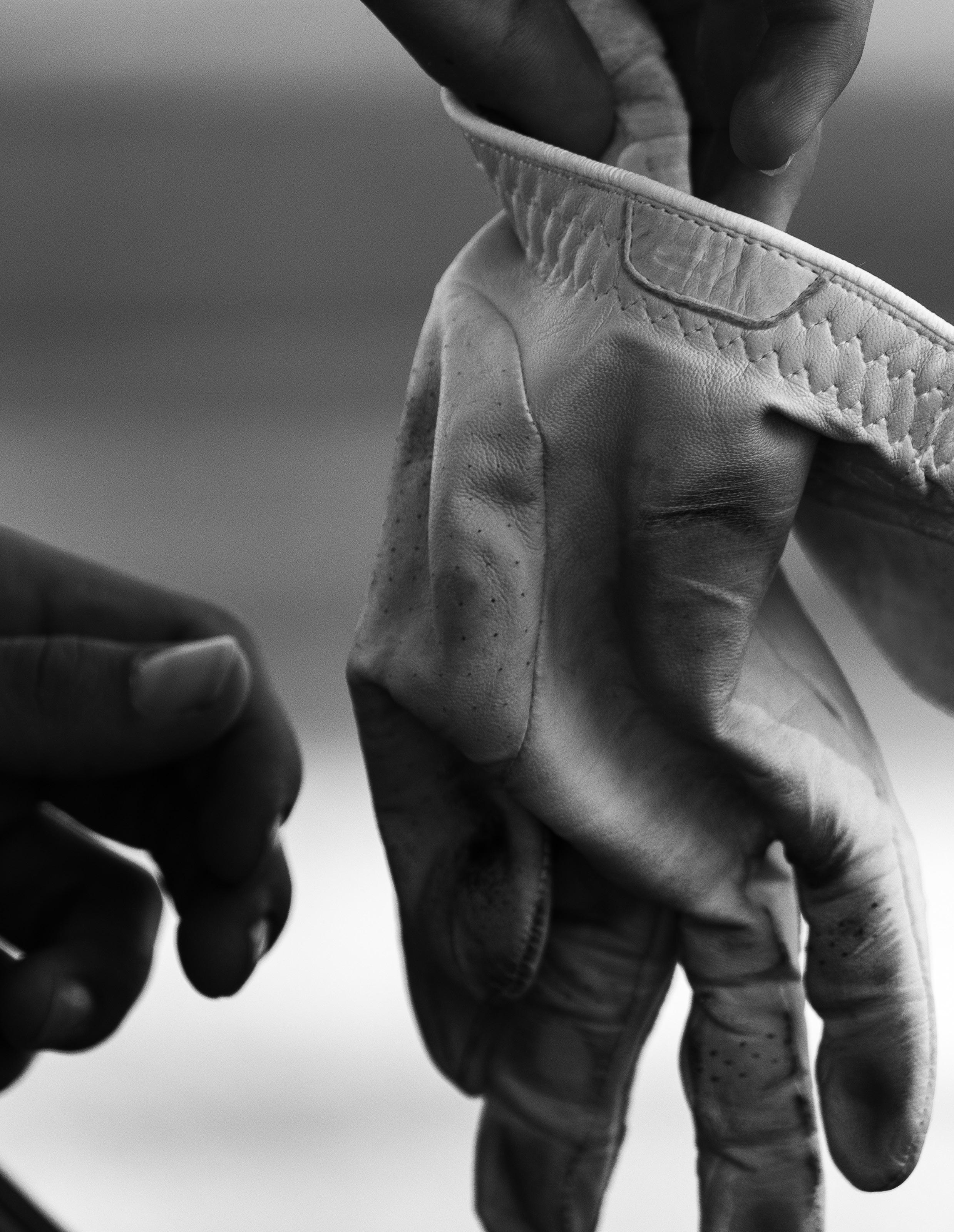

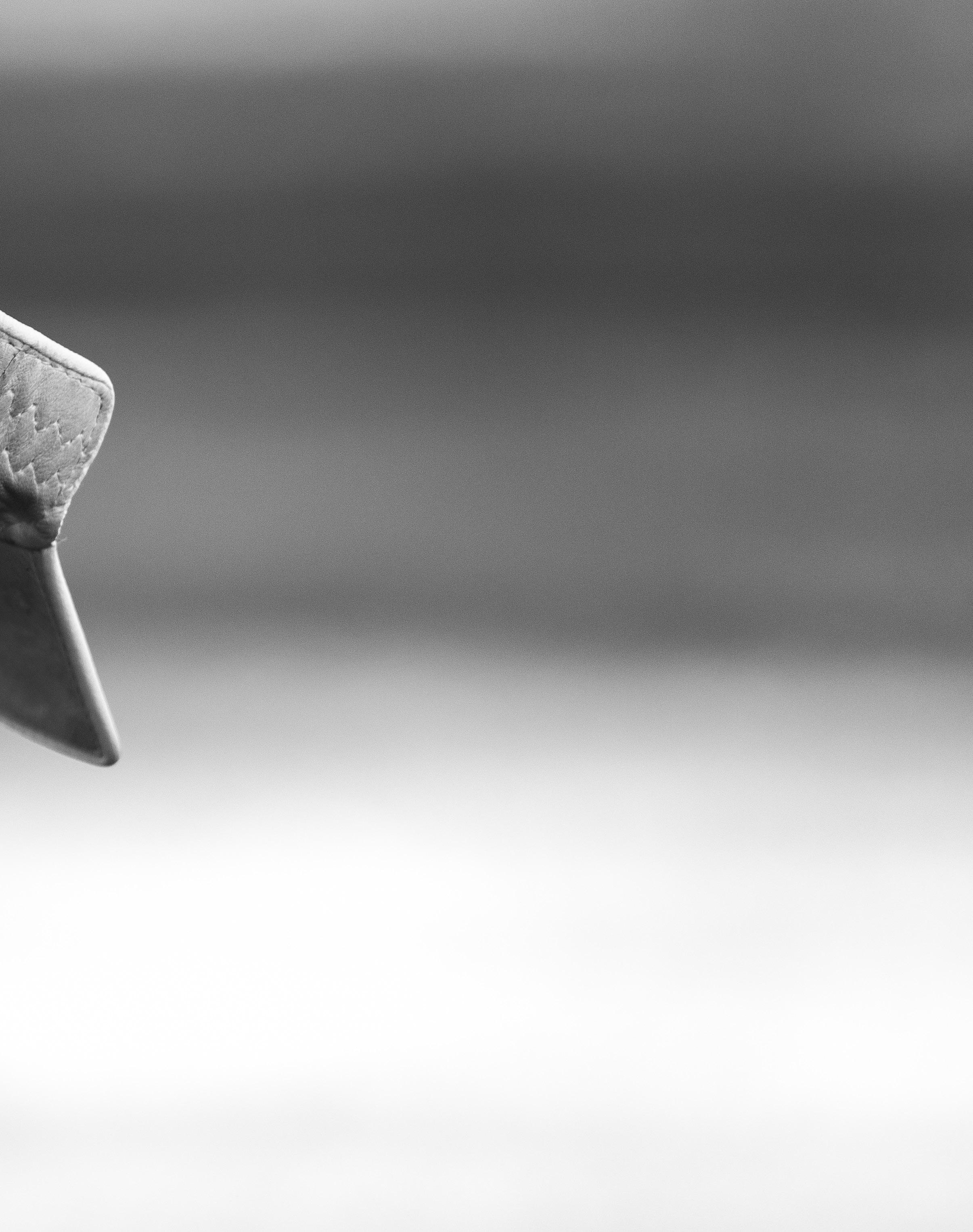
Words by Brandon Genson
Anthem Golf & Country Club
May 30 -J une 1, 2024
Cody Massa (-14) made up ground in a hurry to win the 2024 Arizona Mid-Amateur Championship.
Trailing Chris Kamin by three strokes entering the third and final round, Massa knew he had to put pressure on the two-time AGA Player of the Year before he caught steam. He matched Kamin with a birdie on the first hole and took the lead when Kamin found trouble in the desert on the third hole. Massa went on to card seven birdies during a red-hot front nine to capture his first AZ GOLF major championship and solo win.






Grayhawk Golf Club - Talon
June 3-5, 2024
16-year old Nikki Oh (-2) topped defending champion Ashley Menne and University of Arkansas rising senior Kendall Todd to become one of the youngest players ever to win the 2024 Arizona Women’s Amateur Championship at Grayhawk Golf Club’s Talon Course.
With her father caddying, Oh credited her victory to smart decision making throughout the tournament. With birdies on holes 16 and 18 during the second round, Oh became the co-leader with Todd. Oh took the lead when Todd found trouble early in the final round. Despite a brief challenge from Menne late, Oh secured the win when Menne faltered on the 17th. Oh’s impressive win earned her a spot in the 2024 U.S. Women’s Amateur Championship at Southern Hills Country Club.






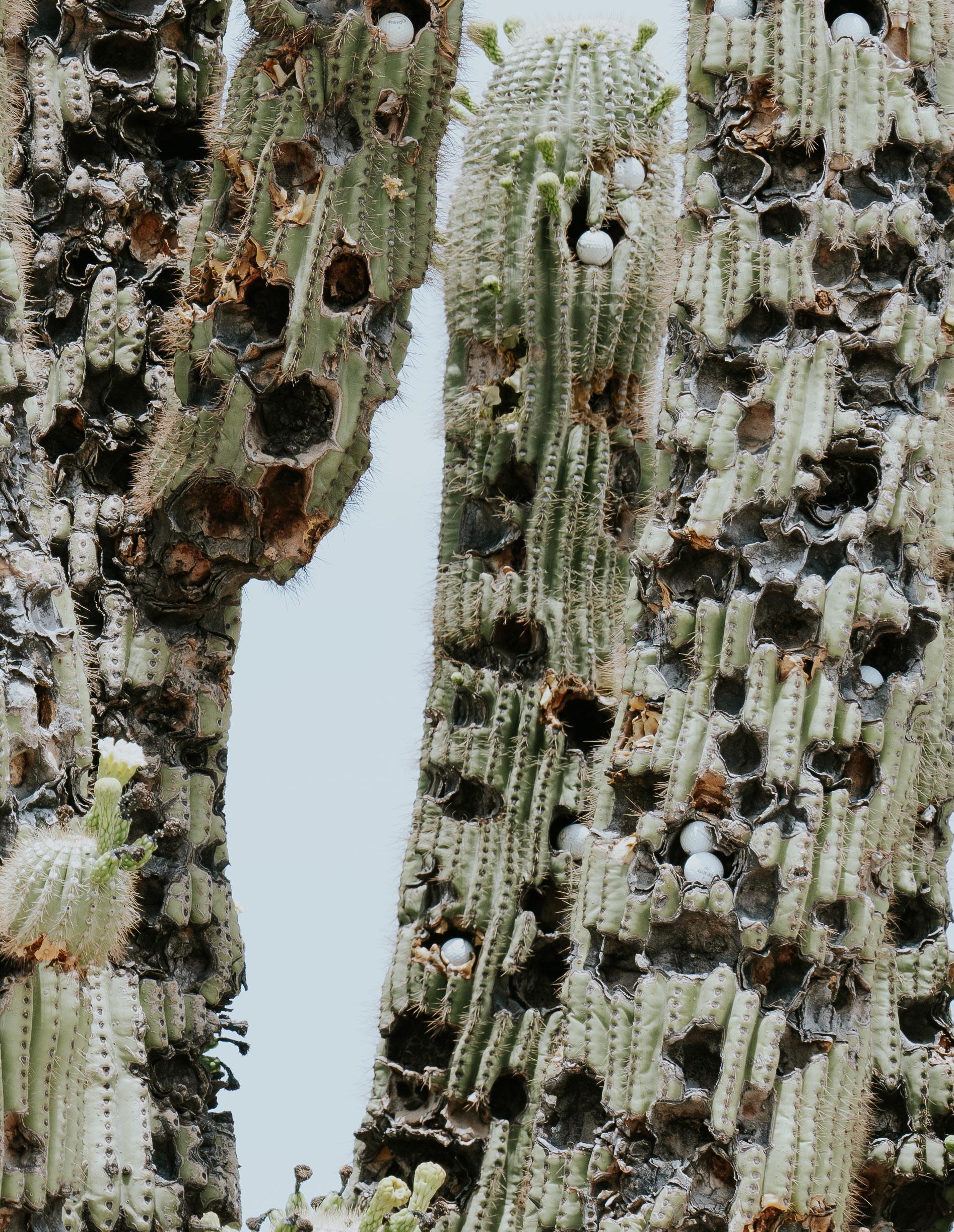

Phoenix Country Club
June 17-22, 2024
142 of Arizona’s best amateur golfers met at the site where it all began, Phoenix Country Club, for the 100th Arizona Amateur Championship. For six days, they dueled under the radiant summer sun, bearing 30mph winds and temperatures up to 117 degrees. Only one golfer was still standing at the end of the sixth day, stroke play medalist and number 4 golfer in the Rolex AJGA Rankings - Wheaton Ennis. After firing 65-65 (-10) through the first two rounds of stroke play, Ennis never took his foot off the gas as he went through the gauntlet on his way to his first Arizona Amateur Championship title, knocking off 2023 NJCAA Champion and Grand Canyon University’s Warner Beach, former Latinoamèrica Tour player Hans Reimers and two-time Arizona Amateur Champion, Jake Chanen.
Ennis’s consistent and poised play led him to topping Gilbert’s Carl Miltun 3 & 2 in Saturday’s (June 22nd) championship match. The Texas A&M commit has earned himself a tee time at the USGA U.S. Amateur Championship at Hazeltine National Golf Club in Minnesota and a 10-year exemption into the Arizona Amateur Championship.

